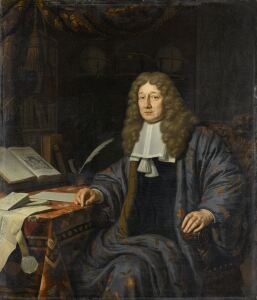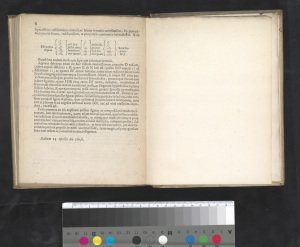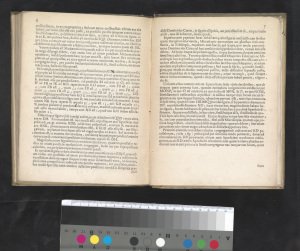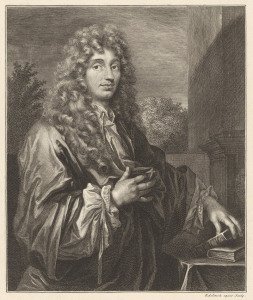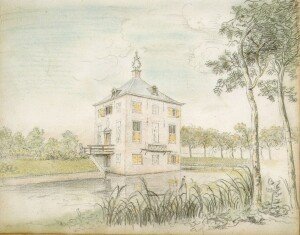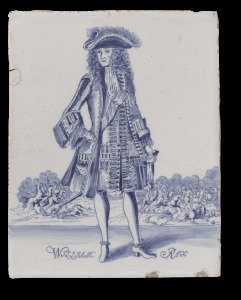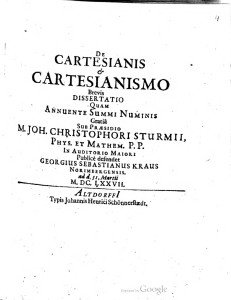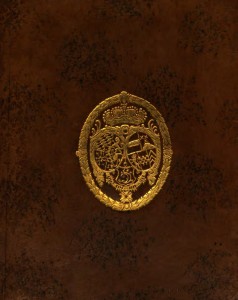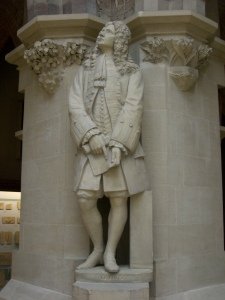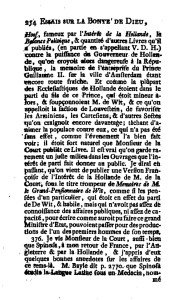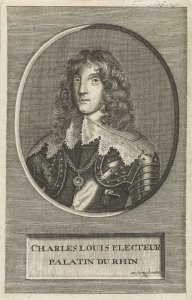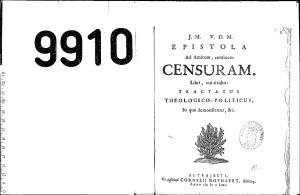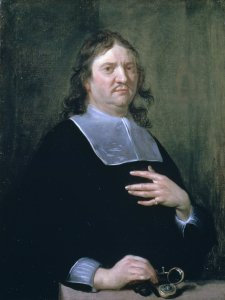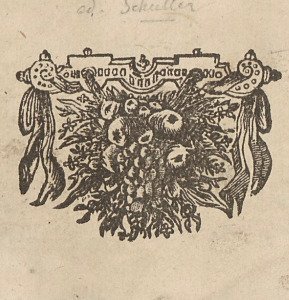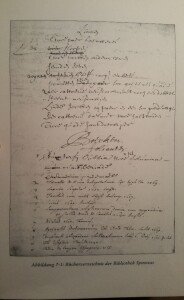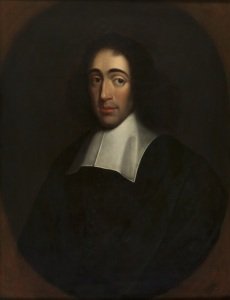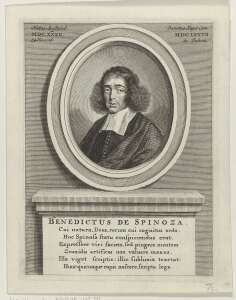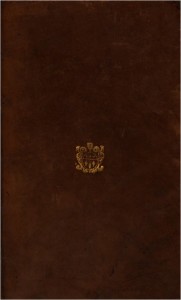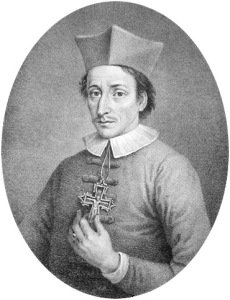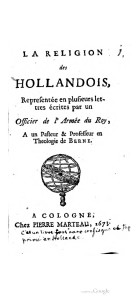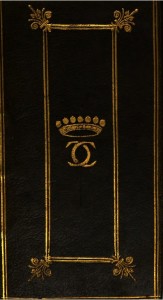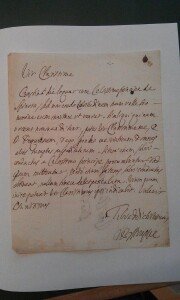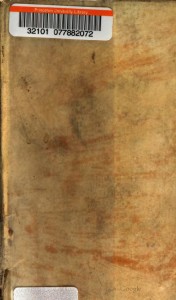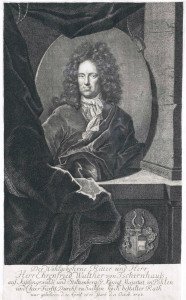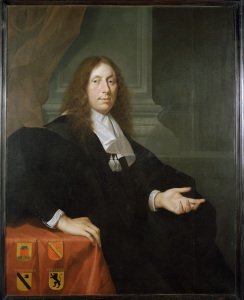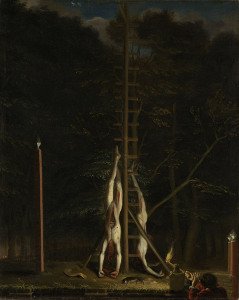People
Anne-Marie traded and acted as a financier up to 1666. Cf. De Bruyn Kops, 2007, p. 284.
Read moreNothing is known about Matthatias Aboaf, except for the fact that the funeral service of his son was attended by Spinoza's father Michael on June 24, 1641 (cf. Hagoort, 2008, p. 35). Michael also visited Matthatias funeral on March 20, 1644 (Hagoort, 2008, p. 89, 105).
Read moreJudah Leon Abravanel was a Portuguese Jewish physician, poet and philosopher. His work Dialoghi d'amore (Dialogues of Love) was one of the most important philosophical works of his time. He was born of Castilian Jewish heritage in Lisbon, and wrote his most important work in Italian. See: https://plato.stanford.edu/entries/abrabanel/.
Read moreHerman Aeltsz was a printer in Amsterdam between 1656 and 1681. See: Van Eeghen, 1960–78, vol. 3, p. 14; Jagersma and Dijkstra, 2013, passim. It must be assumed that it was the book's publisher Jan Rieuwertsz Sr who interfered with the logistical aspects of the book production. Rieuwersz Sr.—under Spinoza's own full name—issued a translation in 1664 under the title Renatus Des Cartes Beginzelen der Wysbegeerte, I en II Deel; Overnatuurkundige Gedach... Read more
Theodorus Jansonius ab Almeloveen was Dutch physician and polyhistor. He studied (1676) theology in Utrecht and medicine in Leiden, and became professor of Greek, history, rhetoric and medicine (1701) in at Harderwijk University. Almeloveen earned a reputation for his works on philology and bibliography, for exampe with Bibliotheca promissa et latens (1692). See: NNBW, vol. 6, cols 31–2; De Graaf, 1989.
... Read moreJacob Alting studied in Groningen, and was ordained as a priest in the Church of England. He held the chair of oriental languages at Groningen University (1641) and was appointed professor of theology (1667) there. He crossed swords with Maresius on issues of biblical exegesis after the latter had accused him (1668) of heterodoxy. He was involved in some refutations of Spinoza's TTP, and enthusiastically started drawing up arguments from the books of Ezra and Nehemi... Read more
Antonio Alvares (fl.1641–55) was a jewel merchant who moved from Paris to Amsterdam, where he lived with Isaack and Gabriel Alvares in a house called De vergulde valck (‘The guilded falcon’) in the Uilenburg quarter (cf. Spinoza, mercator & autodidactus, p. 65).
Soon after the takeover of the trading company of Michael (1655), Spinoza got involved into a financial conflict with Antonio Alvares, and his two brothers (April 1655). The issue was ... Read more
Gabriel Alvares (fl.1641–55) was a jeweller. He owned two mills for cutting diamonds (cf. Vlessing, 1997, p. 22; id., 2002, pp. 148–9).
Read moreSamuel A. Andreae studied theology in Heidelberg, Groningen (1658) and Basle. He held a chair (1665) of history and Greek in the university of Herborn (1665), and took out his doctoral degree in Theology (1671). He worked in the Marburg theology department of the Philippinum (1687–93).
In July 1670 Andreae received a letter from Mieg indicating that the latter knew that Spinoza was the writer of the TTP.
... Read moreFisherman Tommaso Aniello (or Masaniello) led an uprising against the Spanish rulers of Naples and the Neapolitan nobility in 1647. See: Coniglio, 1955 (uprising and Aniello); DBI.
According to Colerus, among Spinoza's personal belongings there was a sketchbook containing drawings in ink and charcoal that all depicted ‘several prominent people who were known to him and who occasionally paid him a visit’. Hence, it may be conjectured that most of the... Read more
Antoine Arnauld studied theology at the Sorbonne. He was ceremonially stripped of his doctoral degree and condemned as a heretic for his attack (1656) on Jesuit casuistry (Théologie morale des Jésuites, Paris, 1643). He was the leader of the convent Port-Royal de Paris, and a fervent champion of Jansenism. Arnauld corresponded with Descartes and composed the fourth set of objections to the ‘Meditations’ (1641) at the invitation of Mersenne... Read more
Adrien Auzout was a French astronomer and mathematician. He was member of the Parisian ‘circle’ around Mersenne, and a fierce opponent of Hevelius (cf. 1665.10.[22], Ep. 31). He was elected Fellow of the Royal Society in 1666, and was known for his instrumental skills and telescopic observations. See: Brown, 1967; DSB, vol. 1, pp. 341–2.
... Read moreFrancisco Lopes d’Azevedo (fl.1614–41) was a Portuguese merchant in Amsterdam with privileged relations with Lisbon. He engaged in the import-export business of textiles amidst others (cf. Israel, 1990, p. 429). He may be the same individual as Francisco Lopes d’Asseveda, an accountholder of the Amsterdam Wisselbank in 1646 and 1647.
... Read moreBenedict Baddel was probably from the French town of Bassin. He took his oath (1626) as notary public on the recommendation of Amsterdam. As a public notary he got in contact with many merchants and businessmen, including Michael and Spinoza. He authored Poëmes d’amours, Amsterdam, 1616. See: Mellot, 1991; Bosma, 1998, p. 32, no. 25.
... Read morePieter Baert (fl.1665–1702) was a Regius professor of hydrography in Dunkirk (1676) and Toulon (1680). He was a member of the Académie Royale des Sciences. In 1684, Baert issued the geometrical Traité de la pendule à cycloide (Marseille). See: Cassini, 1710; NNBW, vol. 1, col. 224; Ziggelaar, 1973; Pouvreau, 2008, pp. 67–9; Villiers, 2013.
Spinoza was in contact with Beart from 1655 onwards. In a letter to Christiaan ... Read more
Francesco Barberini was a nephew of pope Urban VIII (1568–1644). He was created cardinal in 1623, and later became Grand Inquisitor (1633–79). He was one of the judges in the Galileo trial (1633) who refused to condemn his old family friend. He was founder of a rich library at the palazzo Barberini and patron of intellectuals like Athanasius Kircher. See: I Barberini e la cultural Europea del seicento, 2007.<... Read more
Simon Barkman (fl.1638–46), ‘a neighbor of Hans D Amory’, was active as a merchant in Amsterdam most likely. He may be identified as an accountholder of the Wisselbank (1646, 1647) also named Simon Berckman. See: Bosma, 1998, p. 126, no. 596.
Read moreJean de Barthon fled to the United Provinces in 1652. He was the son-in-law of the Dutch legal scholar Hugo Grotius and had connections with William III. In 1661, he joined a French infantry regiment serving in the States army. Montbas was promoted ‘Colonel te paard’ (‘colonel on horseback’) in 1669. His military decisions to defend the Betuwe at the Rhine in June 1672 ended his States career abruptly. In late July 1672, he defected to the French. See: NNBW, vo... Read more
The Walloon minister Jacobus Johannes Batelier (or Watelier) was formally deposed from his ministry (1619). During an aggressive dispute on Remonstrant theology, Batelier crossed swords with the Utrecht theologian Gisbertus Voetius in: Confutatio insulsi et maledici libri, n. p. (Utrecht?), 1637. He also reversed Voetius’s protégé Martin Schoock in: Gisberti Voetii … seu methodus disputandi adversus Remonstrantes …, n. p. (Utrecht), 1637). See: N... Read more
Jacob Bayle (fl.1631–85) was Reformed minister working in Montauban and Carla-le-Comte (now Carla-Bayle). He published (1682) his brother’s Critique générale, a reaction to a work on the history of Calvinism by the ex-Jesuit Louis Maimbourg (1610–86). Bayle’s critique led to his arrest in June 1685 when the campaign against French Huguenots reached its height with the Revocation of the Edict of Nantes. See: BBK, vol. 1, cols 432–3.
... Read moreBalthasar Bebel studied in Straatsburg and Wittenberg. He took out his doctoral degree (1662) in Theology at Straatsburg University, and held a chair of theology in Straatsburg. He was a member of the so-called Leipzig Collegium Anthologicum (1655).
Bebel was asked by Von Boineburg to compose a rebuttal of the TTP.
... Read moreBalthasar Bekker was a Dutch minister and author of philosophical and theological works. Opposing superstition, he was a key figure in the end of the witchcraft persecutions in early modern Europe. His best known work is De Betoverde Weereld (1691), or The World Bewitched (1695).
Read moreKoenraad van Beuningen was a Dutch diplomat and Amsterdam Burgomaster. He was a colourful, influential figure with a keen interest in philosophy and theology, and was sympathic to Quaker ideas. He was secretary (1642) of Grotius, and headed numerous diplomatic missions for the Dutch Republic. See: NNBW, vol. 7, cols 118–120.
According to a certain testimony, Koenraad van Beuningen had been curious what a philosopher like Spinoza would have... Read more
Hieronymus van Beverningh (sometimes spelled Beverningk) was a prominent Dutch regent, diplomat, amateur botanist, and maecenas, who lived during the Dutch Golden Age. He was assigned to assist William III in negotiations with Charles II to break off his alliance with France. See: NNBW, vol. 7, cols 118–120.
Read moreAdriaen (VI) Adriaensz van Blijenburg was Lord of Naaldwijk. He studied law in Leiden (1643). He was member of the Dordrecht Vroedschap (1642–3, 1651–2) and Burgomaster (1656–8, 1676–7). He was also a member (1673–6) of the Raad van State and the Gecommitteerde Raden of Holland in the Zuiderkwartier. In 1666, Van Blijenburg was appointed as an adviser to plan the education of the young Prince of Orange. His friends include the humanist scholar and p... Read more
Thomas Blount studied law at the London Inner Temple. His main interest was in legal history, historical research and literature. He clandestinely published A Catalogue of the Lords, Knights and Gentlemen, of the Catholick Religion …, (n. p. (London?), 1660), a work stressing the royalism of English Catholics in the time preceding the Restoration of Charles II of England. A productive writer, Blount also authored: Nomo-lexicon: a Law Dictionary …, n. p. (London), 16... Read more
Jacob Boeve (fl.1651–68) came from Middelburg. Names of the Boeve family are listed in the registers of the Dutch Church in Austin Friars (London). Jacob is also mentioned in the well-known diaries of Samuel Pepys, who describes him as a merchant, solicitor and lawyer living at Chancery Lane, London (cf. Pepys, 2000, vol. 6, p. 206).
On 20 July 1651, Michael signed a power of attorney before public notary Benedict Baddel in Amsterdam. In this deed, proving that Michael cou... Read more
Elizabeth of Bohemia was the eldest daughter of Elector Palatine Frederic V of Wittelsbach (1596–1632) and Elizabeth Stuart (1596–1662). She joined (1661) the Lutheran convent of Herford (Westphalia), and was appointed abbess of the convent (27 or 30 April 1667) which gave her a seat in the German Diet. She was befriended by, among others, Descartes and Leibniz. Descartes' Les Passions de l’âme (Passions of the Soul) was the re... Read more
Johann Christian von Boineburg came from an influential Hessian family of politicians and made an impressive career at the Court of the Elector of Mainz. In 1653, he became a Catholic, a decision which caused his temporary arrest in 1664. Von Boineburg cultivated the acquaintance of Leibniz in 1668 and together they planned strategies to change European politics. He also assigned him to make a catalogue of his vast library (completed in 1671). See: Paasch, 2003. Von Boineburg owned Le... Read more
Cornelis Bontekoe received his formal education as a town surgeon and enrolled (1665) at Leiden University. He studied medicine under Van Horne and Dele Boë Sylvius, as well as philosophy under Geulincx. He was personal physician (1683) to the ‘Great Elector’ of Brandenburg. See: Krul, 1891, pp. 25–6; Thijssen-Schoute, 1989, esp. pp. 276–337 and 342–3; Noack and Splett, 1997, pp. 65–72; DDP, vol. 1, pp. 128–32; Schweikardt,... Read more
Hans Bontemantel was a noted Republican patrician and member of the Amsterdam Vroedschap (cf. De Jager 1853–4). He had a career as a magistrate in Amsterdam from 1650 onward. Bontemantel was removed from office by William III in 1672, at the onset of the Third Anglo-Dutch War (1672–4, a part of the larger Franco-Dutch War, 1672–78). In 1670, Bontemantel sat in the States of Holland and wrote a daily report of its sittings, during one of which TTP was discussed (Smit,... Read more
Ole Borch studied medicine (1644) at Copenhagen University, and attended lectures of the Cartesian Leiden professors Abraham Heidanus, Johannes de Raey and Adriaan Heereboord. He visited the entomologist Jan Swammerdam in Amsterdam (The Letters of Jan Swammerdam, 1975, pp. 5–6), and becaome professor of philology in Copenhagen (1660). A pioneer of experimental science, he authored De ortu et progessu chemiae dissertation, n.p. (Copenhagen, 1668... Read more
Adam Boreel came from Middelburg. He was the founder of a ‘college’ of Arminian freethinkers in Amsterdam (mid 1640s),and had a keen interest in alchemy and optics. He kept a large correspondence with the universalist ‘circle’ in England around Samuel Hartlib as well as with other correspondents, like Isaac Beeckman, Mersenne and Robert Boyle. A skilled Hebraist, Boreel studied the Mishnah (a massive non-biblical Jewish document) w... Read more
Giovanni Alfonso Borelli was interested in applied mathematics, mechanics in astronomy and animal physiology. He was one of the first scholars to calculate comets to be moving in elliptical orbits. See: DSB, vol. 2, pp. 306–14; Boschiero, 2007, pp. 59–92; id, 2008 (on comets); DBI.
... Read moreIn late July 1673, Spinoza travelled from The Hague (still under Dutch command) to town of Utrecht by then occupied by the French army. It is documented that he carried in his pockets a dated and signed passport of the French general Louis II de Bourbon—the illustrious Prince of Condé who stayed in Utrecht from 31 April to 25 July—and, quite likely, also one from the Prince of Orange. The occasion for the trip was an invitation officially directed to him b... Read more
Franciscus dele Boë Sylvius (1614–72) taught anatomy and medical practice in Leiden from the late 1640s onwards. A fervent supporter of the theory of the circulation of the blood (1637) propounded by William Harvey and a noted scholar in cerebral anatomy, he attracted many gifted students: Niels Stensen, Lodewijk Meyer, Johannes Bouwmeester and Adriaan Koerbagh. At least one of Sylvius’s early private Leiden lessons on the lymphatic system (1640) was attended by Desca... Read more
Johannes Theodoor Braun studied theology (1654) in Leiden under Johannes Coccejus. He was Walloon minister in Delft and Nijmegen (1661–80). Braun earned a reputation with Vestitus sacerdotum hebraeorum (1680) which would lead to his appointment as professor of Hebrew and theology in Groningen (in succession to Jacob Alting). Braun crossed swords with the Voetian reformer Johannes a Marck (1656–1731) on the implications of Cocceianism. In 1702, he publis... Read more
Daniel Bredan was a public notary in Amsterdam from 1630 onwards. He contributed an inscription to an album amicorum (The Hague, KB, ms. 76 H 6) of Johannes Montanus, in 1624. Furthermore, he translated several French political and religious tracts into Dutch (Verclaringhe des conings van Vranckrijck, Amsterdam, 1634. See: Bosma, 1998, p. 40, no. 72).
Read moreThe Rotterdam wine trader Johannes Bredenburg had no university training. It appears, though, that he was a bright spirit who read translations of the works of Spinoza, Descartes, Thomas Hobbes and Meyer (cf. Israel, 2010, p. 94). See: NNBW, vol. 4, cols. 292–3; BLGNP, vol. 3, pp. 56–8; Van Bunge, 1990b, passim; DDP, vol. 1, pp. 155-9.
... Read moreJacob Bueno (fl.1636–1646) was one of the Parnasim of the Portuguese-Jewish congregation Bet(h) Jacob (Spinoza, mercator & autodidactus, p. 15, III,4a) together with Michael d'Espinosa (1636–7). He is mentioned in the burial registers (1639–48) of cemetery Beth Haim. Cf. Hagoort, 2008, passim.
... Read morePaul Buissière was a French physician and anatomist, and Surgeon-General (1689) to the English forces in Ireland. He was a member of the Académie Royale des Sciences and Fellow (1699) of the Royal Society. Buissière published about certain scientific affairs: Lettre à M. l’abbé D.L. sur les vértitables effets de la baguette de Jacques Aymar, Paris, 1694 (Vermeir, 2012, passim). See: ODNB.
Pierre Desmaizeaux ... Read more
Franco Petri Burgersdijck was a neo-Aristotelian logician who studied in Leiden (1610) and Saumur (1614). He held the Leiden chair of logic (1619), and taught ethics (1620–8) and physics (1628–35). Burgerdijck’s eclecticism is shown in his efforts to combine the Peripatetic philosophy with the humanist tenets of men like French logician and reformer Petrus Ramus. His fame especially rests upon Institutionum logicarum libri duo … (Leiden, 1626; r... Read more
Spinoza and Burgh, a friend and declared disciple of Spinoza until 1673, wrote intensely about the latter's conversion to Roman Catholicism that year, see 1675.09.03/11, Ep 67 and [1675/76].00.00, Ep 76.
Read morePieter Burman Sr. (1668–1741) studied in Utrecht and Leiden, where he also took out his doctoral degree in Law with the disputation De transactionibus (1688). Back in Utrecht, he was appointed (1696) extraordinary professor of eloquence and history. Later, he lectured Greek and political science in succession to Graevius. Pieter focused on editing the works of Phaedrus, Horace and Ovid among many others. Pieter was accused of voicing spinozist notions. See: NNBW, vol. 4, co... Read more
Benjamin Idanha made a living as a merchant and was treasurer of the Sephardi congregation in Wisselbank (cf. Walther and Czelinski, vol. 2, pp. 85–6).
Read moreMichael died of yellow fever in Willemstad.
Read moreSamuel (Saul) de Caceres (Carceris, Casseres, Caçeres) studied under the supervision of Haham Samuel Levi Morteira. He delivered the eulogy at Morteira’s funeral (Bodian, 1999, esp. p. 165). Samuel was a sopher (i.e. a scribe, notary, also someone who tought children the Jewish Bible) who worked for Beth Jacob. He was a librarian of the society Ets Haim (‘Tree of Life’), and edited, revised, and corrected a Spanish translation of the Ferrara Bible (published posthumously... Read more
Giuseppe de Campani worked in Rome as a clockmaker, mechanic, astronomer and commercial optician. He was the builder of huge powerful long-focal-length refracting telescopes of great excellence. Constantijn Huygens Sr possessed a so-called ‘Campanine’. See: Bedini, 1962; DSB, vol. 3, p. 23; DBI.
... Read moreAntonio Fernandes Carvajal settled as a importer of wines in London (c.1635), where he became an influential merchant and shipping magnate. He was the principal grain contractor for Cromwell's armies in the war on Spain (1654). He became an English citizen, converted openly to Judaism, and led the Portuguese Jewry in England to worship privately. He founded the first post-expulsion synagogue in London (Creechurch Lane) in late 1656 (cf. Samuel, 2... Read more
Johannes Casearius received his formal education at the Latin School of Franciscus van Enden in Amsterdam (cf. Meinsma, p. 182; Meijer, 1902a, p. 399). ‘Casuarius’ (Casearius) is quite probably the same individual as ‘Johannes Cassarius’ who matriculated as a philosophy student at Leiden University on 12 September 1659. Presumably, he is also the same as ‘Johannes Casear’ who studied theology (21 May 1661) in Leiden. After his st... Read more
Giovanni Domenico Cassini I taught astronomy in Bologna. He was the director (1671) of the Royal Observatory in Paris. His brilliance and reputation rests upon many scientific achievements: the ‘Cassini ovals’, the first measurement of the size of France, and the discovery of the big red spot on Jupiter, an observation he shared with Robert Hooke. See DSB, vol. 3, pp. 100–4; Van Helden, 1999, pp. 48–65.
... Read moreJeremias Casteleyn (fl.1646–53) lived in a house named In de Stadt Praagh (‘In the City of Prague’) at the Herengracht (cf. Elias, 1903–5, vol. 2, p. 888). He was accountholder (1646–7) of the Amsterdam Wisselbank.
Read moreThe reputation of church historian William Cave principally rests upon two works: Antiquitates apostolicae: or the History of the Lives, Acts and Martyrdoms of the Holy Apostles of Our Saviour, … (London, 1676; rev. edn, London, 1677), and Scriptorum ecclesiasticorum historia literaria: a Christo nato usque ad saeculum XIV. facili methodo digesta …, 2 vols (London, 1688; Geneva, 1688–98). See: BBK, vol. 1, cols 962–3; LThK, vol. 2, p. 985; ODNB.
On ... Read more
Urbain Chevreau entered the Parlement de Paris at the age of 29. He was the personal secretary (1633) of Christina Wasa, Queen of Sweden. He made the acquaintance of Fabritius in 1658 and it was through him that he was invited to the Court of Heidelberg between 1671 and 1678 (cf. Mayer, 1923, p. 24). Chevreau earned a reputation as author of the eight-volume Histoire du monde (Paris, 1686) and Chevraeana, 1697.
The initiative to approach Spinoza for a professorship was ... Read more
Francisco Mendes Chillon (fl.1641–57) was a merchant from Amsterdam in the import business of textiles. He was also accountholder of the Amsterdam Wisselbank (1646–7), and had close business relations with the Sephardi community in Hamburg. See: Swetchinski, 1975, p. 171, Annex B.
... Read moreChristina is remembered as one of the most educated women of the 17th century. She was fond of books, manuscripts, paintings, and sculptures. With her interest in religion, philosophy, mathematics and alchemy, she attracted many scientists to Stockholm, wanting the city to become the "Athens of the North". She was intelligent, fickle and moody; she rejected what the sexual role of a woman was at the time. She caused a scandal when she decided not to marry and in 1654 when sh... Read more
The Jesuit Christoph Clavius was an eminent, traditional mathematician who was held in high esteem by most scholars of his time including Galileo Galilei. Clavius’s reputation primarily rests upon the replacement (1582) of the old Julian calendar—accepting an accumulated error of ten days—by the Gregorian calendar, now the internationally accepted civil calendar. His Opera mathematica and Euclides elementorum were reprinted in several editions and translations. See: DSB, ... Read more
Jean Le Clerc was a Swiss theologian and biblical scholar. He was famous for promoting exegesis, or critical interpretation of the Bible, and was a radical of his age. He parted with Calvinism over his interpretations and left Geneva for that reason. Le Clerc published Sentimens de quelques theologiens de Hollande sur l’histoire critique du Vieux Testament (Amsterdam, 1685), a work which made him an instant celebrity in the ‘Republic of Letters’. See: DDP, vol. 1, pp... Read more
Henry Clerke was a virtuoso physician. He took out his doctoral degree in Medicine in 1652, and was deputy lecturer in anatomy (1657). See: ODNB. Clerke is mentioned in the correspondence between Oldenburg and Spinoza (cf. 1665.12.18, Ep. 33).
Read moreJohannes Coccejus held a chair of Hebrew and theology (from 1643) at Franeker University, and a Leiden chair of theology (1650). His popular Opera omnia, which includes a Hebrew lexicon, were edited in 1673–5, 1689 and 1701. See: NNBW, vol. 1, cols 616–8; BBK, vol. 1, col. 1072; BLGNP, vol. 4, pp. 92–8; LThK, vol. 2, col. 242; Van Asselt, 2001; Feil, 2001, pp. 22–33. Coccejus’s private book collection (about 1,856 lots) was auctioned on 14 April... Read more
Jacob Codde is mentioned (1637, 1641) in the municipal archives of Amsterdam as a buyer and owner of a house called De Vergulde Windhond (‘The Guilded Greyhound’) in the Jodenbreestraat.
Read moreJ. Coenen was probably Johan Coenen, a junior judge’s clerk at the Supreme Court in The Hague, but of this there is no certainty. The latter worked at the Supreme Court of Holland, Zeeland and West-Friesland between 1654 and 1681. He was also secretary (1661–81) of the so-called Sociëteit van ’s-Gravenhage (Society of The Hague, an institution founded for collecting taxes and the repayment of money lent by citizens from The Hague to the United Provinces). S... Read more
Jean Baptiste Colbert was Marquess de Seignelay. He was Contrôleur général des finances (1665–83) under Louis XIV of France. He built up the French economy by levying taxes, reclaimed lands and rights, and improved roads and canals. He was the founder of the ‘Manufacture royale de glaces de miroirs’ (the corporation Saint-Gobain S.A.) where the Huygens brothers purchased their glass. Colbert was a fervent supporter of the arts and scienc... Read more
Alexandre Colins was Esquire and Viscount of Aherée (1662). He served in the Dutch States’s army (from 28 April 1672 onwards), and fought in a German regiment in the service of the Spanish King. He contributed (c.1677) to the album amicorum of the Reformed Dutch pastor Gerard Croese (1642–1710).
Read moreLourens de Collenaerts (fl.1652–64) traded in Bordeaux from 1647 onwards, and was an accountholder (1646–7) of the Amsterdam Wisselbank. He was succeeded by Anne-Marie.
Read moreSybrant Cornelisz was a notary public (a common-law notary) who was admitted to the profession in 1616. In 1635 he bought a manor (nowadays called ‘Amstelrust’) at the Amsteldijk (no. 319) named Groenhoven (‘Green Court’). The earliest known document mentioning Michael's name as an Amsterdam entrepreneur is an affidavit (a sworn statement of fact) in Dutch made by Cornelisz on October 8, 1627. The affidavit reads:
M... Read more
Isak Coronel was a business partner of Michael d'Espinosa in Amsterdam most likely. He may be the same individual as Ysack Coronel mentioned in the burial registers (1639–1648) of the Portuguese-Israelite cemetery Beth Haim (cf. Hagoort, 2008).
Read moreIsabelle Correa was a poet and translator. She was one of a few female Jewish poets in the Netherlands before the 19th century.
Read moreIsaac da Costa worked as a merchant in Amsterdam. On 10 May 1655, he signed a legal document before Benedict Baddel to confirm the identity of someone named Elias de Pas, together with, among others, Spinoza.
Read morePieter de la Court was a Dutch economist and businessman, and the origin of the successful De la Court family. He pioneered modern thinking about the economic importance of free competition and was an uncompromising advocate of the republican form of government. Pieter de la Court was the pupil of Cartesian professor Adriaan Heereboord. Pieter was a textile merchant in Leiden. He moved to Amsterdam (1655) and lived at the ‘Fluwelen Burgwal’. See: NNBW, ... Read more
Theodorus Craanen studied medicine in Utrecht (1651), philosophy and theology in Leiden (1655) and, finally, medicine in Duisburg (1656). He held the chair of philosophy (1671–3) in Leiden. He established a ‘mechanical-philosophical’ school based entirely on Cartesian concepts which he exchanged with the chair of medicine. With regard to anatomy, Craanen explained human physiology in mechanistic terms defined by Gassendi and Descartes. A prol... Read more
Louis Crayers lived at ‘Op de boomsloot’. He was a lawyer and a professional curator in Amsterdam. Two years (early April 1658) after Spinoza was officially declared a minor, the municipal Weeskamer assigned Crayers to protect Rembrandt's son, Titus van Rijn, from losing his father’s entire inheritance. Crayers, who defended the noted painter against a claim of one Isaack van Hertsbeeck, owned one of his paintings (depicting Rembrandt and his wife), which he... Read more
Hasdai Crescas originated from Catalonia. He earned a reputation for his knowledge of Talmudic law, and was a rigid critic of Aristotelian thinking (especially Moses Maimonides), in favour of Jewish doctrine and philosophy. See: Wolfson, 1929; CCS, pp. 77–8; Lagerlund, 2011, vol. 1, pp. 454–6. See: https://plato.stanford.edu/entries/crescas/.
In the concluding portion of Spinoza's letter to Lodewijk Meyer of April 20, Spinoza dis... Read more
Oliver Cromwell rose to a position of military prominence during the First Civil War (1642–6). He played a major role in the creation of the New Model Army. After the start of the Rump Parliament (1649–53), he became chairman of the Council of State (1649) and Lord Protector (1653) of the First and Second Protectorate Parliament (1654–5, 1656–8). He proclaimed the restriction of the freedom of religious sects and the revision of government and the arm... Read more
Antonio Dagurre is listed (1646–7) as accountholder of the Wisselbank.
Read moreFrancisco was listed (1646–7) as accountholder of the Wisselbank. On 10 December 1653, Michael d'Espinosa signs a protest of non-payment of two wisselbrieven before notary public Benedict Baddel. One was owed to him by the brothers Dagurre (the acceptors). This is actually the last document in the Amsterdam town archives that refers to the business activities of Michael as head of the Espinosa firm.
... Read moreJoseph Solomon Delmedigo was a rabbi, author, physician, mathematician, and music theorist. Spinoza had a copy of at least one of Delmedigo's works in his library (Abscondita Sapientae).
Read moreRené Descartes was a French philosopher, mathematician, and scientist. Some have called him the father of modern Western philosophy, much of subsequent Western philosophy is a response to his writings, which are studied closely to this day. See: https://plato.stanford.edu/entries/descartes/.
Read morePierre Desmaizeaux lived and worked in England as a cultural translator and correspondent for scholarly Franco-Dutch periodicals. He edited the works of John Locke and translated the works of Pierre Bayle and Saint-Évremond into English. See: Almagor, 1989.
Desmaizeaux wrote about the relationship between Saint-Évremond and Spinoza. The French libertine claims to have been in some regular contact with Spinoza and he puts forward details about the... Read more
Willem Deurhoff was an excentric, eclectic autodidact philosopher who mainly wrote on the necessity of God’s workings, Cartesian dualism and Christology. He was accused of being a Socinian and spinozist, but that last classification is doubtful, because he believed in miracles and God’s free will. Another clear-cut distinction which distances him from Spinoza was that there was a difference between the Creator and creation. A peculiar idea of Deurhoff was that the first act of ... Read more
Johannes van Diemerbroeck earned a doctoral degree in Law at Utrecht University (De injuriis et famosis libellis) on 8 October 1668. On the same day, he was officially permitted to work as an advocate for the Hof van Holland (Album advocatorum, p. 109). A man of considerable wealth, he lived at the Domskerkhof (Utrecht, HUA, DTB, inv. no. 45,4, fol. 254), and owned the manor ‘Koeckenhoeff’ and land in Schalkwijk (HUA, 34-4: ‘Notarissen in de stad Utrecht 1560&nd... Read more
Salomon Dierkens was a legal scholar. Cf. De Vet, 2005. See also: Petry, 2005, esp. p. 147.
Read moreJohanna van Dobben (fl.1644–69) married (7 June 1644) Willem van der Werve.
Read moreOliver Doiley (fl.1671–94) received his formal education at Eton. He studied law in Cambridge and took out his doctoral degree in Law also there. He was vice-provost and Senior Fellow of King’s College. No original works of him are known.
Philippus van Limborch, either late in January or early February 1671, sent over acopy of the TTP to Cambridge. In a letter dated 23 January, he informed Oliver Doiley that a ‘concealed Amsterdam bookse... Read more
Manuel Duarte was an Amsterdam jewel trader.
Read moreManuel Levy Duarte was a successful Amsterdam merchant who, together with Jacob Athias, operated in the jewellery trade with London under the name of ‘Athias and Levy’ (1661–90).
Read moreJohann Conrad Dürr was professor of moral philosophy (1654) and theology (1657) at Altdorf. He published the first independent Lutheran ethical system in Enchiridion theologiae moralis (Nuremberg, 1662), and issued many books, like Ethica paradigmatica (Jena, 1670) and Compendium theologiae moralis (Altdorf, 1675).
Dürr delivered an academic speech to celebrate the promotion of twelve philosophy candidates to the academic level of magister (equivalen... Read more
Nicolaas Heinsius the Elder was an expert in textual criticism. He was intelligencer and collector of manuscripts and books in the service of Christina Wasa. See: NNBW, vol. 2, cols 560–563; Blok, 1999, passim; DDP, vol. 1, pp. 407–8.
Shortly after the (undocumented) return of Spinoza from Utrecht to The Hague, on 23 August 1673, Spinoza goes to the house of The Elder, probably to deliver to him some books or a message of Graevius. Yet, he soon fin... Read more
In 1605, Pêro and Mor fled from central Portugal (Vidigueira), making their way to the relatively safe French town of Nantes. In 1621 the Espinosa family relocated to Amsterdam. Pêro Espinosa was buried (row 9, no. 20) at Beth Haim (Spinoza, mercator & autodidactus, p. 4, I,B.). The burial register has the following text:
On 9 April 5387 [of] the year 1627 is buried Isaac de Espinosa, who came from Nantes to Rotterdam where he died, and he is buried in Beth Haim... Read more
Sara died on 7 January 1625. She was buried in row 8, no. 9 at the Portuguese-Israelite cemetery of the Amsterdam Talmud Torah congregation in Ouderkerk aan de Amstel. The text of the burial register ‘Livro de Bet Haim’ reads as follows:
On 7 January is buried dona Sara Espinosa, sister of Abraham Espinosa of Nantes and her grave is in the eigth row, no. 9, next to the wife of Daniel de Fonceqa.
(‘Livro de Bet Haim’, quote... Read more
The place of Hanna's birth, Amsterdam (Vlooienburg), is uncertain. The inscription on the headstone of the grave of Hanna Deborah at Beth Haim reads thus:
Read moreGrave of Mrs. Hanna Deborah d’Espinosa, spouse of mr. Michael d’Espinosa, who was taken up by God on 28 d Cheshvan of the year 5399’.
Michael d’Espinosa (Spinoza’s father) was the son of these Portuguese emigrants. Presumably, he was born the second son of the wealthy merchant Pê(d)ro Roiz Rodrigues Espin(h)osa and his wife Mor Alvares either in 1587 or 1588. Both of Michael’s parents originated from central Portugal (Vidigueira, north of Beja at the edge of the upper and lower province of Alentejo). Because of the rigours of the Portuguese Inquisition they fled to Nantes in t... Read more
Both Mirjam's date of birth as well as the exact location are unknown, but can be calculated from the date of Mirjam’s marriage registration (1650) with Samuel de Caceres in Amsterdam in the summer of 1650. On 2 June 1650, 'Mariam spinosa van A, out 21 Jaer’ (Mirjam d’Espinosa from A[msterdam], 21 years of age) and ‘Samuel de Caseres van A, out 22 Jaer’ (Samuel de Caseres from A[msterdam], 22 years of age), officially register their inte... Read more
Hester de Espinosa's parents were deceased at the time of the registration of her forthcoming nuptials with Michael d'Espinosa: ‘geen ouders hebbende’ (without parents) (Spinoza, mercator & autodidactus, p. 21, III,11a). The marriage registrars were Henrick Dircksz Reynst and Outgert Pietersz Spiegel (cf. Dapper, 1663, Appendix ‘Namen van de schouten’).
... Read moreThe exact date of the marriage between Michael and Rachel is uncertain. Some stress 1620 as the date of their marriage. However, 1622 or early 1623 is also possible (Meinsma, p. 56).
Rachel, Michael’s first wife, died in [Amsterdam] on 21 February 1627. No details are known about the circumstances of her death. She was buried (row 9, no. 18) at Beth Haim in Ouderkerk aan de Amstel on the same day. The text in the burial register ‘Livro de Bet Haim&rsquo... Read more
Gaspar Fagel was a Dutch statesman, writer and quasi-diplomat who authored correspondence from and on behalf of William III during the English Revolution of 1688. Fagel took a doctoral degree in Law (1653) at Utrecht University. He was pensionary of Haarlem (1664–70), judge’s clerk for the States General (1670–2), and Grand Pensionary of Holland (1672–88). He was appointed Grand Pensionary only three days after the murder of the De Witt brot... Read more
Pedro de Faria was a member of the Contractacion of Nantes, an organisation of French and Iberian Catholic merchants enjoying economic privileges in the maritime trade with the Spanish town of Bilbao (cf. De Bruyn Kops, 2007, pp. 262 and 284).
Read moreIsaac Aboab da Fonseca was a rabbi, scholar, kabbalist and writer. In 1656, he was one of several elders within the Portuguese-Israelite community who excommunicated Spinoza. Da Fonseca came with his parents to Amsterdam during the 1610s. As a star pupil in the rabbinate, he became a haham at the age of 21. He worked as a haham in the Dutch Brazilian colony in the 1640s (cf. Emmanuel, 1955, p. 5) and was appointed chief rabbi of the Portuguese-Israelite community of Amsterdam in the s... Read more
Abraham de Fonseca (fl.1641–7) was an accountholder (1646–7) of the Amsterdam Wisselbank. He was a highly successful businessmen and prominent investors in Dutch trading networks. Perhaps he was the same individual as one Abraham Fonseca who is mentioned several times in the burial registers (1639–1648) of cemetery Beth Haim (cf. Hagoort, 2008, passim).
... Read moreThomas Fonteyn (fl.1630–61) was abookseller and publisher in Haarlem and Amsterdam (Voorburgwal, from 1653 onwards). He produced works on various subjects ranging from religion and poetry to songbooks and mathematics. In 1654, he issued a second edition of the Nederlandt-sche woordenschat (Amsterdam, 1650) which was revised and augmented by Lodewijk Meyer. See: NNBW, vol. 2, cols 453–4.
... Read moreRuy Gomes Frontera (fl.1622–38) was a member of congregation Bet(h) Jacob. He worked as a physician in Amsterdam, and wrote a letter of criticism (1625) to the Parnassim about the high costs of tombs at the Portuguese-Israelite cemetery Beth Haim. See: Hagoort, 2005, p. 33.
... Read moreChristoph Bernhard Freiherr von Galen was Prince-bishop of Münster. He was born into a noble Westphalian family. Von Galen declared war (14 September 1665) on the Dutch to gain access to the North Sea coast on account of the disputed border-territory of the lordship of Borculo. See: BBK, vol. 2, col. 166; LThK, vol. 4, col. 490. Since the English were busy negotiating peace with Spain, Louis XIV of France—entangled in a peace treaty (1662) with the Dutch to help out ag... Read more
Galileo Galilei was an Italian astronomer, physicist, engineer, philosopher, and mathematician. He played a major role in the scientific revolution of the seventeenth century. Galileo's championing of heliocentrism and Copernicanism was controversial during his lifetime, when most subscribed to either geocentrism or the Tychonic system. See: https://plato.stanford.edu/entries/galileo/
Read moreJean Gallois was a French scholar and abbé. He was a client of the Controller-General of France Jean Baptiste Colbert. Gallois was a librarian and geometer in the service of the French Académie Royale des Sciences (1669), and lectured (1668) mathematics at the Paris Collège royal. He was elected (1672) Fellow of the Académie française. His friends included Pierre Daniel Huet and Henri Justel. Gallois’s most noted work is Breviarium Co... Read more
Henrique Graces (fl.1598–1619) originated from Porto and settled in Amsterdam between 1598 and 1605. He was buried at Beth Haim on March 13, 1619 (‘Livro de Bet Haim’, Walther and Czelinski, vol. 1, p. 183, no. 6), after he was circumcised (sic) to permit burial (cf. Bodian, 1999, p. 33).
... Read morePierre Gassendi was a French philosopher, priest, scientist, astronomer, and mathematician. He held a church position in south-east France, but spent much time in Paris, as the leader of a group of free-thinking intellectuals. He was also an active observational scientist, publishing the first data on the transit of Mercury in 1631. See: https://plato.stanford.edu/entries/gassendi/.
... Read moreArnold Geulincx was a rationalist philosopher. He was a lecturer in logic in Leiden (October 1662), and an extraordinary professor (1665) in the Leiden Statencollege. Geulincx authored Gnôthi seauton (1675), which was edited (under the pen name ‘Philaretus’) by the physician Cornelis Bontekoe. He also authored the (unfinished) Metaphysica vera, Amsterdam, 1691. Geulincx’s Opera omnia came out in the 1890s: Land, 1891–3. See: NNBW, vol. 10, cols 282–3; DDP, vol. 1, pp. 322�... Read more
Johan Antonides van der Goes was a poet and playwriter. He dedicated his poem De Ystroom to Cornelis de Vlaming.
Read moreJacob Golius was an Orientalist and mathematician at the University of Leiden. He published and translated (in) Arabic. His best-known work is an Arabic-to-Latin dictionary, Lexicon Arabico-Latinum (1653), which he sourced for the most part from the Sihah and Qamous dictionary.
Read moreChristoph Joachim Nicolai von Greiffencrantz represented (1693–9) the Duchy of Holstein in Essen (East Frisia, north west Germany). Von Greiffencrantz sojourned as an envoy in The Hague and Vienna and corresponded extensively with Leibniz (from 1697 onwards, 266 letters). After Von Greiffencrantz’s death, his son negotiated with Leibniz about the sale of his father’s manuscripts (cf. Müller and Krönert, 1969, p. 253).
Sebastian Kortholt&... Read more
Dirk van der Groe was officially admitted as notary public on 7 October 1670. Presumably, he lived in the Beursstraat or somewhere close to the Exchange Bank. See: Bosma, 1998, p. 65, no. 222. Van der Groe was involved as a notary in the dispute between Hendrick van der Spijck, Rebecca de Spinoza, and Daniel de Casseres after Spinoza's death.
... Read moreJacob Gronovius was a Dutch classical scholar and theologian, who studied in Leiden, Oxford and Cambridge. He was professor of history and Greek language (1679) and of rhetoric (1692) at Leiden University. Gronovius entertained a large correspondent network. As a writer, his fame mainly rests on Thesaurus antiquitatem Graecarum (Leiden, 1697–1702), a thirteen-part work devoted to classical literature and archeology. See: NNBW, vol. 1, cols 986–9.
Between ear... Read more
Fabritius in his letter to Spinoza (cf. 1673.02.[26], Ep. 47) urges Spinoza to write back to him as soon as possible, for example via Jacob de Groot. De Groot came from The Hague. He studied philosophy in Leiden (1643), and was a permanent representative of the Elector Palatine in The Hague. See: Schutte, 1983, pp. 213–4, no. 200.
... Read moreHugo Grotius was a Dutch jurist who laid the foundations for international law. He was imprisoned for his involvement in the intra-Calvinist disputes of the Dutch Republic, but escaped hidden in a chest of books. He wrote most of his major works in exile in France.
Read moreJosua Habilho was a wealthy sugar merchant who settled in Amsterdam in 1598 (cf. Walther and Czelinski, vol. 2, p. 84).
Read moreFrançois Halma was a pressman and publisher in Utrecht, Amsterdam (1699–1710) and Leeuwarden. He authored works ranging from poetry and dictionaries to an anthology of Reformed church music and translations of the works of Pierre Bayle. See: NNBW, vol. 6, col. 690.
... Read moreHans Coenraadt Breghtel originated from Nuremberg, and came to The Hague in about 1640. He is first mentioned as a member of the local guild of St Luke in 1657. In 1669, Breghtel lived at the Noordeinde, in a house called ‘de Spiegel’ (‘the Mirror’). Some of Breghtel’s pieces are still preserved today (Leiden, Lakenhal, inv. no. 3192: ‘goblet of the Winter Queen’). See: Peelen, 1915; Van Gelder, 1982, p. 41.
Spinoza vi... Read more
Samuel Hartlib was a German-British polymath. An active promoter and expert writer in many fields, he was interested in science, medicine, agriculture, politics, and education. He settled in England, where he married and died. He was a contemporary of Robert Boyle whom he knew well, and a neighbour of Samuel Pepys in London in the early 1660s.
It is entirely uncertain how contacts between Henry Oldenburg and Spinoza were established or arranged and by wh... Read more
William Harvey was an English physician who made seminal contributions in anatomy and physiology. He was the first known to describe completely and in detail the systemic circulation and properties of blood being pumped to the brain and body by the heart.
Read moreFabritius in his letter to Spinoza (cf. 1673.02.[26], Ep. 47) urges Spinoza to write back to him as soon as possible, for example via one 'Gilles van der Hek'. He may be identified with a Gilles van der Heck Sr (fl.1643–83) who worked as an agent and intelligencer for the Duke of Braunschweig-Lüneburg-Calenberg (Hanover) in The Hague (1672–83). See: Schutte, 1983, pp. 290–1, no. 316. There is also the distinct possibility that he should be iden... Read more
Adriaan Heereboord was a neo-scholastic Cartesian logician and philosopher. He studied theology and philosophy in Leiden (1629), and held a chair in ethics (1644). He intervened in the Leiden row about Cartesian philosophy and provided Descartes with all the necessary information to write his letter to the university senate (AT V, 1–15, 35–9; 22–3, 29–31 (board of university governors to Descartes)). He is credited for in... Read more
Abraham Heidanus was a Dutch Calvinist minister who was sympathetic to Cartesianism. In early 1676, Heidanus was banished from Leiden University because of his hard-lined Cartesianism. Soon after promulgation of the resolution, the Leiden theologian Abraham Heidanus issued (17 April) his counter-arguments in a pamphlet simply called Consideratien (Considerations). His prime focus was to rail loudly and publicly against the senate’s anti-Cartesian resolution by essentially p... Read more
Frederik Hendrik was the Prince of Orange and stadtholder of Holland, Zeeland, Utrecht, Guelders, and Overijssel from 1625 to 1647. As the leading soldier in the wars against Spain, his main achievement was the successful Siege of 's-Hertogenbosch in 1629.
Read moreFairly nothing is known about Pedro Henriques, except for the fact that he worked as a Portuguese merchant in Amsterdam. On 8 June 1638, Michael and Ruy Gomes Frontera became the trustee of the bankrupt estate of Pedro Henriques (who had died recently).
Read moreLandgrave Ernst von Hesse-Rheinfels-Rotenburg was from 1649 to 1658 his death Landgrave of Hesse-Rheinfels and from 1658 until his death Landgrave of Hesse-Rheinfels-Rotenburg. He was a correspondent of Leibniz and friend of the latter’s erstwhile patron, the Hessian Count Von Boineburg. He embarked upon a military career in his younger years. In 1652, he converted with his wife Maria Eleonore von Solms-Hohensolms-Lich (1632) to Roman Catholicism.Read more
Johannes Hevelius was a councillor and mayor of Gdańsk, then part of the Polish-Lithuanian Commonwealth. As an astronomer he gained a reputation as the founder of lunar topography and described ten new constellations, seven of which are still recognized by astronomers. Hevelius had a large personal observatory (‘Sternenburg’). He preferred observation with the naked eye and used ancient instruments, like the Ptolemaic quadrant and the alidade (using the line of ... Read more
Höjerus may have been from Danish extraction, even from the United Provinces. Perhaps, if he was from Denmark, he may be identified as Andreas Hoierus (from the duchy of Holstein) who matriculated as a student of philosophy at Leiden University on 22 October 1650 (Album studiosorum Academiae Lugduno-Batavae, col. 407).
Read moreAlbertus von Holten studied philology and theology in Rostock, Leipzig, Jena and Altdorf. He entered the service of Count Georg Philipp von Ortendorf in Stuttgart, and held chair of oriental languages in Tübingen (1671). His earliest correspondence with Leibniz dates from 1670. Two letters from their exchange survived. See: Tietz, 2008, p. 88.
On of these letters, he ends with a brief and brutal remark on Spinoza. The occasion of his reaction is... Read more
Herman Dircksz Homan came from Enkhuizen. He married Jannetjen Gerrits on 26 September 1627 in the Amsterdam Zuiderkerk (Enkhuizen, Westfries Archief, DTB, inv. no. 1707-09,45, fol. 76). He married (sometime before 1664) in second wedlock Geertgen Jansdr Verruyt.
Five years after his expulsion (27 July 1656) from the Portuguese-Jewish community, Spinoza decided to leave Amsterdam and start to live an entirely different and independent life. In the summer ... Read more
Robert Hooke was an English natural philosopher, architect and polymath. Hooke was engaged (1655) by Robert Boyle as his personal assistant because of his skills in designing experiments and building equipment. He was Curator of Eperiments (1662–77), secretary (1677–82) and Original Fellow (since 1663) of the Royal Society. His reputation sprang to prominence with the publication of his Micrographia in 1665, a work on fundamental biology, which also includes... Read more
Jan Claesz ten Hoorn (fl.1671–1714) ran a bookshop and quite probably also a printing firm ‘over het Oude Herenlogement’ (‘nearby the Lords’s Hostel’). Meant is here the noted guesthouse ‘Oude Zijds Herenlogement’ at the Grimburgwal in Amsterdam. The house where Ten Hoorn worked, ‘in de Historieschrijver’ (‘in the Historian’), was situated in ‘het Gebed zonder End’ (‘the Endless Prayer’), ... Read more
In the spring of 1697, bookdealer Timotheus ten Hoorn was subpoenaed by the Amsterdam bailiff for the illegal selling a copy of NS: ‘is gecogt seeker boek in quarto gebonden in een gemormert papier zijnde geintituleerd de naegelate Schriften van Benedictus de Spinosa’ (a certain book is purchased in quarto in marbled paper entitled ‘De nagelate schriften’ by Benedictus de Spinoza’; Peeters, 1982, p. 242). The book was sold for the high price of five guild... Read more
Johannes van Horne studied medicine in Leiden, Utrecht and Naples. He was an extraordinary professor of anatomy and surgery at Leiden University (1653), and first discovered and observed the thoracic duct in the human body. See: NNBW, vol. 7, cols 624–5; DSB, vol. 6, pp. 508–9; Lindeboom, 1984; Huisman, 2009.
If Spinoza, like Tomás Solano y Robles declared, studied in Leiden, is it possible that he followed clinical lessons in medi... Read more
Willem van den Hove came from The Hague. He studied law in Leiden (1671), and became public notary in The Hague. He was advocate to the Court of Holland (Album advocatorum, p. 177).
When Spinoza passed away, Van den Hove made a first provisional (general) inventory of the assets of his modest estate, including common households, grinding materials and the books kept in Spinoza’s small private reference library, on the same day. The inventory is also... Read more
Johannes Hudde was a burgomaster (mayor) of Amsterdam between 1672–1703, a mathematician and governor of the Dutch East India Company. Hudde was a brilliant mathematician who contributed to Van Schooten’s the second edition (1659) of Descartes' Geometria. He had a keen interest in theoretical and practical optics and collaborated with Spinoza in the mid-1660s to build a hand-held refracting telescope.
For the Specilla circularia, see https... Read more
Pierre Daniel Huet was a French churchman and scholar. He took an interest in subjects ranging from anatomy and vivisection to mathematics, astronomy and biblical criticism. Huet was patron and founder of the Académie Physique de Caen (1662–72). A prolific writer, Huet earned a reputation for a teaching edition of the Latin classics (ad usum Delphini). Despite his earlier admiration for Descartes, his attacks on Cartesian epistemology (Censura philosophiae Cartesiana... Read more
Antonius Hulsius studied theology in Geneva, Groningen and Leiden. In 1676, he was rewarded for his efforts to ruin Cartesianism with the regular chairs of theology and Hebrew languages at Leiden University. Hulsius published the anti-Socinian Non-ens prae-adamiticum, … (Leiden, 1656) against La Peyrère's ‘preadamite’ theory, and contested Jean de Labadie’s Le Heraut du grand roy Jesus, … (Amsterdam, 1667) in Le Heraut muet, … (Le... Read more
Samuel Hund (fl.1653–75) was a legal scholar. Konrad Samuel Schurzfleisch wrote in a letter to Hund from 27 March 1675:
Recently, Spinoza composed a particularly monstrous book in which he writes about the liberty to philosophise, and this atheist also defends doctrines and most incapable things. Therefore, this writer deserves to be refuted, as has been done by Johannes Melchioris from the Netherlands.
Source: C.S. Schurzfleisch, Epistolae selectior... Read more
Constantijn Huygens Sr was Lord of Zuilichem and Zeelhem, and personal secretary to the Dutch stadholders Frederik Hendrik and William III. He was a poet, composer, musician and collector. During the so-called ‘stadholderless period’ (1650–72, the political displacement by the States of Holland of the stadholder and the dominant regent House of Orange due to crisis between Republicans and Orangists), Huygens Sr did not play any official role. Throughou... Read more
Lodewijk Huygens was the third and youngest son of Constantijn Huygens Sr. He studied at the Illustrious School in Breda, and was drossaard of Gorinchem and the region of Arkel. He also was member of the Admiraliteit van de Maas. He is mainly considered as a shadowy figure with a reputation for wrangle. See: NNBW, vol. 1, cols 1090–1; Stamhuis, 1996. A meeting (spring of 1676) between Lodewijk and Spinoza is commented upon by Huygens Sr in a letter to He... Read more
Ernst I of Sachsen-Gotha-Altenburg brought about a ‘Golden Age’ in his own land. He promoted the education of common people and introduced a system of modern marriage laws. He was in communication with opticians, such as Hevelius, who built hand-held refracting telescopes for him. See: Vogel, 1990; Keil, 1999.
... Read moreWilliam III (1650–1702) had already been appointed as Field Marshall of the army on 26 February 1672. The promotion to Stadholder of Holland (4 July 1672) and Zeeland (16 July 1672) turned him into a virtual dictator: he disbanded the old town magistracies and replaced them with regents loyal to the House of Orange and the Reformed Church. There is new historical evidence that the Prince of Orange and some of his relatives were involved in organizing or facilitating the murder of the... Read more
Isaac married Hanna in 1674 (cf. Walther and Czelinski, vol. 2, p. 100).
Read moreMenasseh ben Israel was a rabbi, publicist, diplomat and translator. He founded (1626) the first Hebrew printing firm (Emeth Meerets Titsm’h), and persuaded Lord Protector Cromwell to readmit Jewish refugees officially to settle in England. He had contacts with the messianic exegete Isaac de la Peyrère and Isaac Vossius, Queen Christina of Sweden, and the famous Dutch painter Rembrandt van Rijn. See: Menasseh ben Israel, 1989; Bodian, 1999; ODNB.
... Read moreHenry Jenkes was Fellow of Gonville and Caius College (Cambridge). He was an inactive Fellow (1674) of the Royal Society, and published a guide to Christian morality, called The Christian Tutor, or, a Free and Rational Discourse of the Sovereign Good and Happiness of Man …, London, 1683. See: ODNB.
On January 9, 1675, Oliver Doiley sent out a letter to Jenkes to inform him that he had been acquainted with the fact that ‘Spinoza, the author of the impious Tr... Read more
Denis Jennes was a silk and tobacco merchant in Amsterdam and Maarssen where he owned the estate ‘Hogesant’. He had consortiums with other Amsterdam entrepreneurs in the trade with Marocco, and was accountholder of the Wisselbank in 1646 and 1647. See: NNBW, vol. 9, cols 2–3; Kellenbenz, 1958, p. 115; Schorsch, 2004, p. 437.
... Read moreHenri Justel was secretary (1649–50) to Louis XIV of France. He fled to England (1681) at the time of the revocation of the Edict de Nantes, and became chief French agent to the Royal Society. Justel was member of the libertine coterie of Louis II de Bourbon with whom he would have enjoyed ‘libertin’ talk on the nature of the sacraments and on the place of the purgatory (cf. Treasure, 2001). Among his correspondents was Leibniz, with whom he wrote about Spinoza&... Read more
Bartholomeus Keckermann was a Reformed theologian who studied in Wittenberg and Heidelberg. He held a chair in Hebrew in the Heidelberg faculty of philosophy (from 1600 onwards), and was recognised for his logical treatise Systema logicae, tribus libris adornatum … (Hanover, 1611). Spinoza studied his work closely. See: DSB, vol. 7, pp. 268–70; Freedman, 1997.
... Read moreTheodorus Kerckring studied medicine in Leiden (12 May 1659) under Dele Boë Sylvius. He first described the permanent transverse folds of the luminal surface of the small intestine. He was a collector of anatomical and pathological materials he displayed in his house at the Amsterdam Keizersgracht (cf. Kooijmans, 2004, p. 83). In 1678, Kerckring left the Netherlands. He spent time in England and France (where he converted to Catholicism) and finally settled in Hamburg. ... Read more
Willem Kick owned (1619–20) a field outside the St. Andriespoort. He also owned a house on the Nieuwe Houtmarkt and the Breestraat (1639, cf. Van Dillen, 1929–74, vol. 3, p. 239). This fact makes him a likely candidate for being the owner of the house at the Houtgracht rented out to the Spinoza family. Presumably, Spinoza lived in Kick’s house at the Houtgracht with his brother Gabriel, at least until his banishment in late July 1656 from the synagogue of Talmud Tora... Read more
Athanasius Kircher was a Jesuit who lectured ethics and mathematics in Würzburg (1628), and from 1638 onwards physics, mathematics and oriental languages in Rome. He issued about forty works on a wide variety of subjects, ranging from vulcanoes (Mundus subterraneus) and magnetism (Magnes sive de arte magnetica, 1641) to egyptology (Oedipus Aegyptiacus, 1652–4) and technology (Ars magna lucis et umbrae, 1646). See: Fletcher, 2011; DBI.
Kircher's&... Read more
Jacob Statius Klefman studied law in Leiden in 1676. He was private secretary (Geheim Sekretär) and secretary (Rath und Hofgerichtssekretär) in the service of the Duke of Croÿ, Ernst Bogislaw. In his will, Bogislaw charged Klefman to see over his ‘Privatschriften und poetische Gedichten’ (Mueller, 1878, p. 162). For his longtime services, Klefman received from Bogislaw the sum of 1,000 Reichstaler (ibid., p. 170).
On 25 July 1676, Spinoz... Read more
Christian Friedrich Knorr was a Lutheran minister (Generalsuperintendent) in the principality of Grubenhagen (from 1677 onward) and Osterode. Knorr authored many books and he also wrote under the pseudonyms Democritus Christianus and Nathanael Philadelphus (cf. Zenker, 2012, p. 114). For Knorr’s position in the debate on Spinoza and TTP: ibid., pp. 112–9.
Knorr denounced the ‘Theological-Political Treatise’ in an ordinary disputation held exercit... Read more
Johannes Koerbagh studied philosophy in Utrecht (1653) and theology in Leiden (1662). Toghether with his brother Adriaan, he was in close contact (late 1650s, early 1660s) with the coterie around Van den Enden, and Spinoza. Embarking upon a career as a Reformed preacher in 1660, Johannes developed heterodox, spinozistic opinions through his contacts with the Collegiant colleges in Amsterdam which brought him into a virulent conflict with the Kerkenraad in 1666 (cf.... Read more
Christian Kortholt studied theology in Rostock and Jena. He was a lecturer in Greek (from 1660 onwards) at Rostock University, and took out his doctoral degree (12 November 1663). He accepted (1665) the chair of theology at the new Christiana Albertina University in Kiel. He was a zealous adversary of Roman Catholicism and a productive author who primarily wrote books on church history and the history of theology, like De origine et natura christianismi, … (Kiel,... Read more
Sebastian Kortholt lectured on rhetoric and moral philosophy at Kiel University. He corresponded with Leibniz from early June 1700 to 1716. There are some interesting references to Spinoza in his letters, for example in his letter to his father about Spinoza’s self-chosen isolation:
The accuracy of this is confirmed in what the adviser to his serene highness the Duke of Holstein, mr. Christoph Nicolai of Greiffencrantz, someone who kept Spinoza company... Read more
Frans Kuyper studied theology at the Remonstrant Seminarium (founded 1634) in Amsterdam.He was removed (1653) from his ministry in Vlaardingen because of his rejection of infant baptism. He then started (1663–73) a printing shop (Amsterdam, Brouwersgracht) and primarily issued Socinian works. See: NNBW, vol. 4, cols 868–9; Van Bunge, 1990b, pp. 90–8; Visser, 1995. An important participant and pamphletist in the so-called ‘Bredenburg disputes’, K... Read more
Duarte Rodrigues Lamego (fl.1642–55) was a prosperous, influential Portuguese merchant from Rouen. He was an unofficial ‘agent’ providing Portuguese diplomats with information from the French court (cf. Israel, 1990, p. 344).
Because of the debt-ridden and insolvent business inheritance of Michael d'Espinosa (due to turn-over disintegration resulting from losses of cargoes in European waters), Spinoza tried to find an ingenious solution t... Read more
Together with Van Vloten Land published a critical edition of Spinoza’s works.
Read moreThe Lutheran orientalist Johann Michael Lange studied philology, philosophy, medicine, and theology in Halle. He was appointed to the chair of theology at Altdorf University in 1697. Lange was a prolific writer and a staunch champion of pietism, a movement within Lutheranism that advocated the revival of devout Christianity. See: ADB, vol. 17, pp. 601–2.
Read moreFrançois Langenes (fl.1672–82) was a baker from The Hague who had worked (1672) in the service of William III. Langenes was accused by the Kerkenraad of The Hague of having openly spread spinozist tenets (14 November 1681) and ‘strange and unhealthy opinions’ (16 March 1682). Nothing is further heard of his provoking behaviour after June 1682 (cf. Wielema, 2004, pp. 94–5). It would seem that Langenes was influenced by Spinoza. It is however unc... Read more
Merchant Julian Lanson must be identified as Juliaen Lancon, who is listed (1646–7) as accountholder of the Amsterdam Wisselbank. He is presumably the same individual as Jullien Lanson, an entrepreneur who worked in the import-export trade of woollen textiles (cf. Van Dillen, 1929–74, vol. 3, pp. 560 and 581–2).
Read moreThaddeus de Lantman had some notoriety as a religious writer. He worked as a Reformed minister in the local church of The Hague from 1663 up to his death in 1682 and it seems plausible to assume that he at least knew of Spinoza’s controversial reputation. In 1682, theologian and poet Joannes Vollenhove wrote a poem (‘Aan de kerk van ‘s Gravenhage op het overlyden van den here Thadeus de Lantman’) to commemorate his death. Two other works also report a... Read more
Manuel de Lavello is mentioned as a witness to a deed, made by Baddel, dated 9 February 1654, concerning the legal dispute between Rembrandt and his Jewish neighbour Daniel Pinto. See: Vaz Dias, 1936, p. 35. On 10 May 1655, Manuel de Lavello, together with, among others, Spinoza, signed a legal document before Baddel to confirm the identity of someone named Elias de Pas.
... Read moreIsaie Lebourgeois was reported in 1625 as a ‘maistre chirurgien’ (cf. Carel, 1886, p. 150). His address can be gathered from a letter to Oldenburg of 6 June 1672 (Correspondence, vol. 9, pp. 69–72). Oldenburg was informed that letters directed to Lebourgeois through an intermediary had to be addressed in the following manner: ‘A bourgeois Medecin le Jeune a Caen’ (To doctor Bourgeois the younger at Caen). At the post office, those letters had to labelled as ma... Read more
The orthodox Jacob van Leeuwen was a proponent of the appointment of Eduard Theodori Westerneyn during the Voorburg quarrel. See: Westerneyn.
Read moreThe Dutch optician Anthony van Leeuwenhoek crafted highly sophisticated single-lens microscopes, small bi-convex lens framed in two flat and thin metal plates riveted together, allowing magnifications up to 300-fold (a design of Hudde made in the 1660s). He was introduced to the Royal Society by Reinier de Graaf (1641–73) in 1673. Van Leeuwenhoek was a loyal correspondent of the Royal Society—from 1673 onwards, about 560 letters—and bequaethed twenty-six of a to... Read more
Leibniz was a German philosopher and mathematician who occupies an important place in the history of philosophy and mathematics. He argued that the universe is the best possible world that God could have created. See: https://plato.stanford.edu/entries/leibniz/.
Read moreAdriaen Lock took his oath as a notary in 1647. He was involved in the execution of the bulk of the share trade dealings of the Dutch East India Company (cf. Petram, 2011, p. 12). He was also involved in a legal case (1654) between Rembrandt and the Portuguese merchant Diego Dandrade. As a notary, he played a role in the dispute between Spinoza and Antonio Alvares. See: Bosma, 1998, p. 85, no. 337.
... Read moreMendo Lopes (fl.1577–1627) was a Portuguese merchant working in Amsterdam. Lopes was probably the same individual as Mendo Lopes. He is mentioned several times in the burial registers (1639–48) of cemetery Beth Haim (cf. Hagoort, 2008, pp. 75, 103 and 109).
Read moreJohan Louckers (fl.1669–82) was a procurator and notary public in The Hague. Louckers was married to Judith le Petit.
On 8 July 1677, Hendrick van der Spijck files a statement of claim to the Vierschaar of The Hague. The purpose of that claim is a verdict in his financial conflict with Rebecca de Spinoza and Daniel de Casseres to repay him the sum of about 250 guilders advanced for Spinoza’s debts. In the deed, he requests procurator Johan Louckers to ... Read more
The physician and physiologist Richard Lower was elected a Fellow of the Royal Society in 1667. A follower of William Harvey, he enjoyed a reputation for his work on experimental blood transfusion in dogs and in a human being. Lower, who was befriended by Boyle, Wren and Hooke, and particularly earned a reputation for his second book Tractatus de Corde (Amsterdam, 1669), a work on the heart and lungs and blood transfusion. See: ODNB; Donovan, 2004.
... Read moreKarl Ludwig was the second son of the Elector Palatine Frederic V of Wittelsbach (1596–1632) and Elizabeth Stuart (1596–1662). He was the brother of Princess Elizabeth of Bohemia, who corresponded with Descartes on the passions. He received back his father’s possessions in the Lower Rhenish Palatinate during the Peace of Westphalia (1648), and took up residence in Heidelberg. In 1773, he charged Fabritius to approach Spinoza fo... Read more
Niccolò Machiavelli was a humanist political scientist, best known for his radical ‘Il Principe’ (The Prince, 1532). He had a quick career in the Florentine Republic. After the defeat of Florence (1512) by the Medici family, he left politics and devoted himself to a more intellectual life, authoring drama and maintaining a substantial correspondence. See: Ridolfo, 1963 (biography); Pocock, 2003. Spinoza owned two copies of Machiavelli’s works. The fi... Read more
Count Lorenzo Magalotti read law, medicine and mathematics in Pisa. He was secretary (1660) of the Tuscan Accademia del Cimentom and travelled to the Netherlands (1667, 1669), England, Spain and Portugal. He was adviser (1670) of State to the new Grand Duke of Tuscany, who appointed him as a Tuscan ambassador (1673–4) to the Imperial Court of the Holy Roman Empire in Vienna. Magalotti was removed from politics in 1678 and devoted his further life to write Lettere ... Read more
Moses Maimonides blended philosophy and halakhic authority in his writings. His major philosophical work is Moreh Nevukhim (Guide for the Perplexed), in which he ingeniously applies Aristotelian mathematics and logic to religious principles. For background: CCS, pp. 75–7; Fraenkel, 2006; Lagerlund, 2011, vol. 2, pp. 808–15; Parens, 2012. CCS, pp. 75–82; Diamond, 2014. See: https://plato.stanford.edu/entries/maimonides/
Maimonides—whose God (confi... Read more
Miguel Pérez de Maltranila served as a soldier in Flanders. See: ibid., pp. 32 and 66, Annex 2. Pérez de Maltranilla accompagnied one captain Marcos de Avellaneda from Bruges to The Hague in late September 1658. In November of the same year, he settled temporarily in Amsterdam.
Spinoza made the acquaintance of two Spanish travellers, Augustine friar Tomás Solano y Robles (late 1658 or early 1659) and infantry captain Miguel Pér... Read more
Petrus van Mastricht studied in Utrecht, Leiden and Duisburg. He was a theology professor (1667) at the university of Frankfurt an der Oder, and professor of theology and Hebrew in Duisburg (1667). Van Mastricht succeeded Voetius in 1676, presumably as a counterweight against the liberal Frans Burman. His most important work is Theologia theoretico-practica (1655). See: NNBW, vol. 10, cols 591–2; BLGNP, vol. 5, pp. 360–2; Thijssen-Schoute, 1989, p. 450; TDDP, vol... Read more
Erich Mauritius studied law in Wittenberg, Frankfurt an der Oder and Giessen. He was professor of law in Tübingen (1660) and Kiel (1665). He published many works on controversial legal issues, like the persecution of witches (De denunciatione sagarum, 1664). Apparently, he had a keen interest in the New Philosophy with a respectful attitude to Hobbes. See: Nonnenmacher, 2001.
In October 1671, Morhof told Mauritius that Spinoza was probably ... Read more
Johan van der Meer Claesz, lord of Adegeest, married Anna Verboom Jacobsdr. Her father’s cousin was the wife of the Leiden professor Franco Petri Burgersdijck. Between 1673 and 1683, the couple had a total of eight children who were all baptized in the Pieterskerk. See: Petry, 2005, p. 152.
... Read moreJohannes van der Meer was a Dutch Golden Age painter
Read moreJohannes Melchioris studied philosophy in Heidelberg and theology in Groningen (Album studiosorum Academiae Groninganae, col. 97). He was appointed (1682) to the chair of theology at Herborn University. See: Steubing, 1823, passim; ADB, vol. 21, pp. 291–2. For an analysis of Melchioris’s position on TTP and his orthodox vindication of the authority of the Bible: De Vet, 1991; Israel, 2010, pp. 77–8. For his other works: Trocha, 2008, pp. 80–1.
... Read moreAbraham de Mercado (fl.1638–55) was a member of the Jewish community of London. He settled in Barbados in 1655 where he practised as a physician and pharmacist. He was reported as having directed information to the Dutch in Brazil about a Portuguese plot (cf. Arbell, 2002, p. 194). Menasseh ben Israel dedicated the second part of his El Conciliador (1632) to De Mercado.
... Read moreMarin Mersenne was the French minim priest and savant. He was interested in a multitude of domains ranging from mathematics and music theory to philosophy, experimental physics and theoretical optics. His scientific friends, which were in his widespread correspondent network and Parisian cabinet, included many well-known figures. See: Brown, 1967, pp. 31–63; DSB, vol. 9, pp. 316–22.
... Read moreJohann Friedrich Mieg (or Miegius, 1642–91) studied in Heidelberg, Groningen (1658) and Leiden. He was professor of theology at Heidelberg University (from 1665 onwards). Mieg held his inaugural lecture in theology on 15 June 1691 at Groningen University in 1691 and died one month later. See: Drüll, 1991, pp. 103–6.
Although a fair number of scholars in the Leipzig academe at least for a period seemed to have stayed uncertain about the identit... Read more
Gabriel Milan was the son of a Portuguese-Israelite family from Hamburg. He served as a soldier in the French army. He was banker and Crown Agent to George V (1653–1708) of Denmark and Norway, and resided as a banker in Amsterdam (from mid-1660s onwards) and The Hague (1670) and authored reports on political and commercial issues. In 1670, Christian V appointed Milan as Commissioner General of Denmark in the Netherlands and gave him concession (1672) of all c... Read more
Justus Modersohn studied theology at Leuven University, and became a missionary priest in Amsterdam where he founded the vicarage at the Brouwersgracht (1664). He was amember of the chapter of Haarlem (from 1680 onwards). Modersohn published the following work: Conciones in psalmos poenitentiales, seu commentarius litteraris et moralis, Antwerp, 1695. See: NNBW, vol. 8, cols 1158–9.
... Read moreThe pneumatic air-pump experimentation, detailed by Oldenburg in his letter to Spinoza, was part of a series of barometric tests announced on 2 May 1663. These machine-made tests were performed from 10 June 1663 onward in the Royal Society, at Gresham College in Bishopsgate Street, the regular meeting place of the London Fellows (cf. Birch, 1756–7, vol. 1, p. 220; 254-5). The French savant, traveller and diplomat Balthasar de Monconys was also present during the e... Read more
Isaac Montalto was perhaps Ishac Montalto, ‘son of Mose Montalto’. He was buried at Ouderkerk aan de Amstel on 26 June 1644 (cf. Hagoort, 2008, p. 100). On August 25, 1642, Isaac Montalto together with Michael freighted a vessel to set sail for the port of Tétouan.
... Read moreJohannes Montanus (fl.1595–1657) was a teacher at the Amsterdam Latin School.
Read moreAntonio Rodrigo de Morais (fl.1647–56) was a Spanish merchant at Rouen. He settled in London (1680) where he practised Judaism openly. De Morais is recorded in a legal document of the Parlement de Rouen (5 February 1649). See: Oelman, 1986, p. 28.
Read moreBiographical details about Henriquez Morales (or Morelli, fl.1673–1715) are based on a note (1726) by Saint-Évremond. According to the latter, Morales was born in Cairo the son of a Jewish physician and settled in Amsterdam. There, he started his studies in medicine. Morales left Judaism and converted to Roman Catholicism (cf. Saint-Évremond, 1740, vol. 5, pp. 283–6). See: Popkin, 1995, pp. 11–12.
Morales put forward an account about... Read more
Sir Robert Moray served (after 1633) in the army of the Louis XIII of France. He was promoted colonel of the elite Scots Guards (1648), and become Privy Councillor (1651) and Lord of Exchequer for Scotland. He was an amateur scientist and one of the Founder Fellows (6 March 1661) of the ‘Invisible College’ of natural philosophers (the later Royal Society). Moray told Charles II of England about this scholarly venture and secured his approval (15 J... Read more
Morteira was a Dutch rabbi of Portuguese descent He arrived in Amsterdam around 1616. He was rabbi of Beth Jacob, and wrote several works defending Judaism against allegations made by Christian opponents. Fifty of his sermons were published in Amsterdam in 1645 (Giv’at Sha’ul). Twenty-six are still extant in manuscript in Budapest. Conclusive documentary evidence about Spinoza's primary schooling and intellectual awakening is lacking, although one source... Read more
Frederik Muller was a Dutch book collector and bibliographer, and rare book auctioneer since 1847. He brought more than 170 private libraries to auction. See: Mörzer Bruyns, 2004.
Read moreJohannes Müller studied philosophy and theology in Breslau, Wittenberg and Leipzig. He was professor of moral philosophy (1622) at Wittenberg University, and pastor (1627) of the St. Peter and Paul church in Hamburg.
In February 1972, Johann Müller completes the foreword ‘to the Christian reader’ to Atheismus devictus (Atheism Conquered), a thoroughly composed theological analysis of the roots of atheism and the increasing flow of pe... Read more
Johannes Baptista van Neercassel served as Archbishop of Utrecht from 1661 to 1686.
Read moreIsaac Newton was an English mathematician, astronomer, and physicist. He is one of the most influential scientists of all time and a pivotal figure in the scientific revolution. See: https://plato.stanford.edu/entries/newton/.
Read moreJoachim Nieustadt was born in Utrecht in a house of what is now Janskerkhof 25. He studied medicine in Utrecht (1643) and Leiden (1644). He befriended by the Amsterdam Burgomaster Johannes Hudde. He owned (1665–85/6) the manor ‘Groot Noorthuijzen’ in the judicial safe haven of Wijk (near Wijk bij Duurstede where he was appointed Burgomaster in 1681). He was the author of Authentycke copyen der resolutien, van de … Heeren Burgermeesteren ende Vro... Read more
Cornelis Jacobsz Noenaert made a living as a bookbinder (1647) and a printer (fl.1656–96) in Utrecht. He ran a bookshop in the center of Utrecht, in a street called Oudkerkhof. In 1687, he was head of the Utrecht booksellers guild. Noenaert issued a riposte of Spinoza at Utrecht in mid-May 1679.
Read moreMaria Nunes Garces originated from Ponte de Lima (south bank of the Lima river).
Read moreDiego Cardozo Nunes (fl.1624–47) was a Portuguese entrepreneur in diamonds working in Antwerp and Amsterdam. See: Van Dillen, 1929–74, vol. 2, p. 700; Blot, et al., 2000, p. 243. Nunes is listed as an accountholder of the Amsterdam Wisselbank in 1646 and 1647.
... Read moreOn 27 November 1651, Simon Rodrigues Nunes signs an affidavit, written in Dutch, before notary public Benedict Baddel. According to the affidavit, British warships had plundered Michael's carrier and its cargo during transportation from the Canary Islands to the United Provinces: ‘… in the course of his voyage from the Canaries to these lands taken by the English and brought to England’ (quoted in Israel, 2002, p. 134). The costs—for startin... Read more
Gerard van der Nypoort read law in Leiden (1616) and took out his doctoral degree in Law in 1622. He was ‘raad ordinaris’ (ordinary councillor), and one of the Geëligeerden (1671–7) in the States of Utrecht (cf. Lijste, 1723, p. 11; Quint Ondaatje, 1784, Annex E, pp. 167 and 174). He was member of the Chapter of Oudmunster. See: NNBW, vol. 3, col. 924.
... Read moreJan Volkertsz Oli (fl.1635–81) came from Hoorn. He took his oath as public notary on the recommendation of Amsterdam on 16 January 1635. He was buried in the Nieuwe Kerk. See: Bosma, 1998, p. 97, no. 408.
Read moreDavid Israel d’Oliveira may be the same individual as Davi Isarael d’Oliveira, who is mentioned in the burial registers of cemetery Beth Haim (Hagoort, 2008, p. 161).
Read moreNicolás de Oliver y Fullana (alias Daniel Jehuda) was the son of a Jewish noble family in Palma. He fought in several campaigns in Spain, France and Flanders, and had a keen interest in mathematics, cartography and literature. He was a member of the Portuguese-Jewish community in Amsterdam. Oliver y Fullana wrote the history of the society Ets Haim (cf. Van Suchtelen and Petry, 1985, p. 367). Oliver y Fullana married the Jewish poetess Isabella Correa and be... Read more
Baruch d’Osorio was a wealthy Amsterdam merchant in wood and salt. Cf. Hagoort, 2008, p. 5.
Read moreJohannes Heinrich Ott (fl.1665–71) was a correspondent and friend of Leibniz. He received a letter of Oldenburg on his inventions (January 1671). See: Malcolm, 2004, pp. 264–5.
Ott is mentioned in the correspondence between Spinoza and Leibniz, see 1671.10.05, Ep. 45.
... Read moreFew biographical particulars are known about Otterichius, who lived in Remsfeld in the German region of Hessia. He is known to have authored a funeral oration (Frommer und gottseliger alter Leute seelige Heimfahrt, …, Kassel, 1679) for a jurist named Anton von Wersabe. The title-page of the same work refers to Otterichius as a pastor (‘a servant of the divine Word’).
Otterichius denounces the ‘Theological-Political Treatise’ in an ord... Read more
Willem Paecock was engaged in the Amsterdam import-export business. Presumably, he was the same individual as one Willem Pecock (or William Peacock) who signed a request (1665) submitted with the municipal authorities of Amsterdam to lift the ban on the import of English woollen textiles. Another reference to the same person may be one Willem Peacock. He sold a house (in the ‘English’ quarter) on the Zeedijk in 1657. See: Van Dillen, 1929–74, vol. 3, p. 736; Elias, 1903&n... Read more
David Pallache worked in Amsterdam and in the port city of Salé ransoming Dutch prisoners (cf. Garcia-Arenal, 2007, p. 105). He regularly correspondended on those affairs with the representatives of the States General in 1626 and 1627. See: NNBW, vol. 5, col. 422. On 29 June 1634, the Jewish-Moroccan merchant signed a legal document before the notary public Daniel Bredan in Amsterdam. It is indicated in this deed that, in an effort to clear some of his debts... Read more
Joseph Pallache was a merchant, diplomat and pirate, who regularly stayed in The Hague as an agent of the ruler of Morocco. He was burried at Beth Haim cemetery. The record for his grave spells his name as "Palache."
Read moreAuthor and translator Jacques Parrain, Baron of Coutures, first embarked upon a military career, but later dedicated his life to literature and philosophy. He published various works, like for example La Morale d’Epicure (1686). One of his correspondents was Pierre Bayle. See: Houber, 1852–66, vol. 12, pp. 291–2.
From the correspondence of the Huguenot Pierre Bayle it becomes evident that indeed some foreign ‘inquisitive spirits’ had made a seri... Read more
Antoine de Pas, Marquess of Feuquières, was ‘aide de camp’ to the Duc de Luxembourg. He passed the winter of 1672 in Utrecht and was sent to Paris to announce the fall of Woerden to the Sun King. In early April 1673, he was back in Utrecht (cf. Lettres inédits, 1845–6, vol. 2, p. 129). De Pas owned the ‘Regiment de Feuquières’ and was promoted ‘maréchal de camp’. He became involved in a major murder and po... Read more
Isaac Manasses de Pas (also: Marquis de Feuquieres) was a distinguished French soldier.
Read moreJan de Pas may well be identified as Jan de Paz, an accountholder of the Wisselbank in 1646 and 1647.
Read moreBlaise Pascal began his academic career in the natural and applied sciences (fluids, calculating machines, geometry). He made important contributions to mathematics (‘Pascal’s triangle’, probability theory, philosophy of mathematics), and earned a reputation for his clarification of the notion of the vacuum demonstrated by Evangelista Toricelli. A true supporter of Jansenism, Pascal also authored several influential works on theology (Pensées, 1669). See... Read more
Reinhold Pauli studied theology at several German and Dutch universities (Groningen, Franeker, Leiden). He joined Marburg University in the early 1670s where he promoted a new openness to Cartesian philosophy. Pauli wrote a treatise against Spinoza. See: Shantz, 2008, p. 10.
Read moreSamuel Pepys was an administrator of the navy of England and Member of Parliament. He is most famous for the diary that he kept for a decade as a relatively young man between 1660-1669.
Read moreAntonius Perizonius was appointed (1655) to the chair of Hebrew languages in Hamm (Westfalen). From 1666 onwards, he read Hebrew and oriental languages at the Illustrious School of Deventer. Perizonius was a rather minor figure who authored no important original works. See: NNBW, vol. 5, col. 466; BLGNP, vol. 2, pp. 358–9; Touber, 2013, passim.
Perizonius wrote a rejoinder to the 'Theological-Political Treatise,' but the fact is that what was ready of Anto... Read more
Sebastiaan van der Piet came from Vlaardingen, and was admitted as notary public (1621). He was buried in the Westerkerk. In 1639 Van der Piet made a contract concerning the sale of a house in the Breestraat for painter Rembrandt van Rijn.
Read moreDaniel Pinto was involved in a legal dispute with Rembrandt in 1654. The public notary in that dispute, Benedict Baddel, was well acquinted with the Spinoza family.
Read moreVincent Placcius read law in Helmstadt, Leipzig and Orléans. He held the chair of moral philosophy and eloquence at the Hamburg Gymnasium (1675). He was a close friend of the Leipzig anti-Cartesian professor of rhetoric and dialectic Jacob Thomasius, who in his own work on plagiarism appreciated him as an authority on pseudonymous and anonymous writings. See: Hoffmann, 1857; Mulsow, 2006.
Placcius identified Spinoza as the disguised author of Tract... Read more
The physician and experimenter Henry Power, a Royal Society’s Fellow, studied in Cambridge. He discovered the law of gasses (later known as Boyle’s Law). The hypothesis was published in Experimental Philosophy, but Robert Boyle's annoucement preceded the work by one year. See: Webster, 1967; ODNB; DBP, pp. 667–70.
... Read moreJuan de Prado got a doctoral degree in Medicine from Toledo University (1638). He returned to Judaism, and settled in Amsterdam around 1655. He was sentenced (14 February 1657) by the Amsterdam Mahamad to repent in the synagogue for publicly disseminating heterodox ideas and inciting others to start a riot against the rabbis. The case dragged on until 4 February 1658, when the official document of his banishment was signed and the ceremony of absolute severance was... Read more
Johannes de Raey studied medicine in Utrecht and philosophy under Adriaan Heereboord in Leiden. He took out a doctoral degree (1647) in Medicine (1597–1663), and became Leiden professor of philosophy (extraordinarius, 1653–61, ordinarius, 1661). He started to teach Cartesian philosophy in 1647 or 1648 in privatissima. Later he became philosophy professor at the Athenaeum illustre in Amsterdam. De Raey knew René Descartes personally and ... Read more
Lopo Ramirez was a wealthy merchant of Portuguese extraction engaged in the import-export business of jewellery and gunpowder with Portugal and Tuscany. He worked in Amsterdam as an agent for the bankers of King John IV of Portugal. He was a collaborator of Spain who provided (1646) finances of the Spanish delegation to the peace congress of Westphalia. See: Israel, 1994. Ramirez was a member of the Santa Companhia de dotar orphas e donzelas pobres together with Michael... Read more
Petrus Ramus was an influential humanist, logician, and educational reformer. He was killed during the St. Bartholomew's Day Massacre. See: https://plato.stanford.edu/entries/ramus/.
Read moreFriedrich Rappolt was a Leipzig professor of dialectics (1651), professor of poetry (1656) and theology (1670). He was dean of the theology faculty in (1674) and rector of Leipzig University. He was a member of the so-called Collegium Gellianum (founded in 1641), a learned society of Leipzig scholars focusing on the writings of ancient authors. In 1675, Rappolt authored an noted commentary on the work of Horace. See: Rappolt, 1693, Tietz, 2008, p. 51.
Friedrich Rap... Read more
Hendrik Adriaan van Rheede tot Drakenstein was a naturalist, military man, and colonial administrator of the East India Company. He served as a governor of Dutch Malabar and employed twenty-five people on his book Hortus Malabaricus, describing 740 plants in the region.
Read moreHenrick Dircksz Reynst was, together with Outgert Pietersz Spiegel, marriage registar for Hester de Espinosa.
Read moreRembrandt Harmenszoon van Rijn was a Dutch painter. He is generally considered one of the greatest visual artists in the history of art. Rembrandt's works depict a wide range of style and subject matter, from portraits, self-portraits, to landscapes, genre scenes, allegorical and historical scenes, biblical and mythological themes as well as animal studies.
Read moreIn the spring of 1658, Tomás Solano y Robles travelled on the ship Santiago from Gueyana to Rome. The ship was captured by three English privateers near the Canary Islands and brought to London in May 1658. Solano y Robles was imprisoned for almost two months. In the first half of July 1658, he was released. He embarked in London and stopped over in Amsterdam (from 18 August 1658 onwards) to wait for a convoy to bring him back to Spain and further to Rome (cf. Re... Read more
Jan Romboutsz may have been the same individual as the Amsterdam shipowner Jan Rombouts, who started a three-weekly freight service of galiots to Portugal in 1656 (cf. Elias, 1903–5, vol. 1, p. 263).
Read moreTheodorus Ryckius matriculated as a student (1660) of literature and philosophy in Leiden. He was rector of the Latin School in Kampen. He was professor of history and eloquence in Leiden (1672–90), and had a large correspondent network (Epistolae ineditae, 1843). He published the notes and corrections of the Vatican librarian Lucas Holste (1596–1661), on the work of Stephanus Byzantinus (1684), and the complete works of Cornelius Tacitus (1687). See Van der... Read more
What is known about the life and times of Saint Glen is quite sparse. Meinsma in his ‘Spinoza en zijn kring’ briefly deals (pp. 379–80) with him, but it is evident that he grounds what he knows about Saint Glen mainly on Pierre Desmaizeaux's edition of Lettres de mr. Bayle. More biographical information is predominantly made known through the article ‘Un Gazetier français en Hollande: Gabriel de Saint-Glen, traducteur de Spinoza’ publ... Read more
Charles de Marguetel de Saint Denis de Saint-Évremond was educated at the Parisian Collège de Clermont. He embarked upon a military career under Louis II de Bourbon during the Fronde. He was forced to leave France for his royalist stance and stayed in exile in England (1662–5, 1671–96) and in the Netherlands (1665/66–70). Saint-Évremond was an Epicurean writer who excelled in biting satire of topical events and moralist essays. He ... Read more
Claude Saumaise was a French classical scholar.
Read moreSamuel Gottlieb Scholtzius (or Schultz/Scholtz, fl.1649/50–1711) practised physics and medicine in Delft, Rotterdam and The Hague. He contributed (1675) to the album amicorum of the Sedan bookdealer Nicolas Chevalier (1661–1720). It might be conjectured that Scholtzius was asked by the Van der Spijck family to examine and treat the ill and perhaps already bedridden Spinoza. Scholtzius was a relative of Hendrick van der Spijck's brother through the l... Read more
Konrad Samuel Schurzfleisch studied philosophy in Giessen and Wittenberg. He was professor of German history (1671), poetry (1674), history (1678) and eloquence (1700). A prolific writer, Schurzfleisch published many works, ranging from letters to Latin orations and collections on general literature. See: Grafton, 2002, pp. 176–9. For the exchange by Schurzfleisch: Epistolae selectiores, secundum nunc sine lacunis et cum memoria auctoris emendatius ac promulgatae, Wittenber... Read more
Ezra the Scribe (fl.480–40 BCE) was the uncle of the first high priest Joshua and a high priest (1 Esdras). He went to Jerusalem and taught Jewish laws to the Israelites who had returned from Babylonian captivity (Ezra 7:25; Neh. 8:9 and 13). Cf. Pakkala, 2004. In the apocryphal first-century CE book 2 Esdras (14:21–2 and 14: 37–45), also called 4 Esdras, its unknown Jewish author claims that Ezra corrected and restored the whole of Holy Writ through divine insp... Read more
Jacob del Soto (fl.1639–71) is mentioned fin the burial registers (1639–1648) of Beth Haim (Hagoort, 2008). He is referred to as Chatan Bereshit (1639) in one of the sermons of Rabbi Samuel Levi Morteira (Budapest, Rabbinical Seminary, ms. 12 ‘Giv’at Sha’ul’, vol. 5, fol. 6v (Bereshit, Genesis 1:10) (cf. Saperstein, 2005, p. 42). His will caused a conflict in the Amsterdam Sephardi community (cf. Kaplan, 1989, pp. 196–9).
O... Read more
Friedrich Spanheim was the son of the German polemicist and theologian Friedrich Spanheim (1600–49). He took out (1655) his doctoral degree in Theology, and held a Leiden chair of theology (1 November 1670) in succession to Johannes Coccejus. A prolific writer, Spanheim published Summa historiae ecclesiasticae, … (Leiden, 1689) and Controversiarum de religione cum dissidentibus hodie christianis, … (Amsterdam, 1694). In the appendix of the latter compendi... Read more
Outgert Pietersz Spiegel was, together with Henrick Dircksz Reynst, marriage registar for Hester de Espinosa.
Read moreAbraham Jesurum was a merchant specialising in almonds among other goods, who settled in Nantes before 1597 (cf. Spinoza, mercator & autodidactus, pp. 5–6, II,1). A notarial deed of 16 December 1597, preserved in the municipal Amsterdam archives, shows that Abraham Jesurum established business relations there with one Emanuel Rodrigues Vega. Later, Abraham settled in Amsterdam. His name turns up frequently in the Jewish and municipal archives from 18 June 1616 onwa... Read more
Rebecca d’Espinosa married Samuel de Caceres, widower of her elder sister Mirjam, somewhere after 6 September 1651.
After Spinoza’s death on 21 February 1677, Rebecca and her stepson Daniel got involved in a legal dispute over the estate of their deceased brother and uncle. Johannes Colerus writes:
The sister of the deceased, Rebecca d’Espinosa, reported herself as heir of his estate at the house of mourning, but she was not... Read more
Gottlieb Spizel studied theology and philosophy (from 1653 onwards) in Leipzig. He was minister of the Church of St James in Augsburg. He was a prolific writer, fervent book collector, and vast correspondence with people like Athanasius Kircher, Leibniz and Von Boineburg. Spizel, who briefly commented on TTP in Felix literatus ex infelicium periculis et casibus (1676), became especially notorious for a work advocating the persecution of witches, wizzards and atheis... Read more
Spinoza attended Stensen's anatomical dissections in 1662 in Leiden. In 1667, Stensen converted to the Roman Catholic faith. Later, he reproached Spinoza (1675) for his heterodox notions. In 1677, Stensen handed in a denunciation of Spinoza’s philosophy and a manuscript copy (1675) of the Ethica to the Roman Holy Office of the Inquisition, which he had pilfered from the belongings of Spinoza’s friend Von Tschirnhaus.
... Read moreEdward Stillingfleet worked for the Church of England, and was as a clergyman noted for his sermons on doctrinal, historical, pastoral and political issues. He was doctor of divinity (1668), and dean of St Paul’s Cathedral (1678). Later he became bishop of Worcester (1689). He was an apologist of the Church of England, and author of The Unreasonableness of Separation (1683). Stillingfeet was a proponent of Newtonianism. See: ODNB.
On the last p... Read more
Johann Christoph Sturm studied mathematics, physics and theology in Jena (1656–62) and Leiden. He was professor of mathematics and philosophy in Altdorf (1669). Sturm enjoys a reputation in optics for the introduction (1676) of the first reflex camera. That contraption could produce an image on an oiled paper that was stretched across the opening in the top of the camera. See: ADB; DSB, vol. 4, p. 166; Gaab, 2004.
... Read moreClaude Surmondt must be identified as the individual Glaude Surmont, accountholder (1646–7) of the Amsterdam Wisselbank.
Read moreBiographical particulars Jan de Swaen (d. after 1677) are sparse. To all appeances, he was the same as one Jan de Swaen listed (1646–7) as an accountholder in the Amsterdam Wisselbank. His father, Johannes de Swaen (fl.1659–69), a merchant and factor for the Glückstadt Company in Amsterdam, was a brother of Willem de Swaen (fl.1643–73), a zealous Roman Catholic who supported Van Neercassel in financial ... Read more
Martinus Henricus de Swaen studied theology in Mechelen, Leuven (1669) and Paris. He received holy orders in Utrecht in 1677, and worked as a priest (1679) in Assendelft. In 1705, De Swaen published a collection of theological theses in the two-volume Opuscula (Leuven). See: Goethals, 1840–4, vol. 3, pp. 186–95; Ackermans, 2003, pp. 448–9, no. 0586.
On 31 October 1677, Van Neercassel ... Read more
Jan Swammerdam studied medicine in Leiden (1661–3); spent time in Paris where he frequented the salon of the patron Melchisedec Thévenot. He took out his doctoral degree (1667) in Medicine in Leiden, and got praised for his research into the internal anatomy of insects (Historia insectorum generalis, ofte, algemeene verhandeling van de bloedeloose dierkens, 1669) with Antonie van Leeuwenhoek. He was considered a first rank pioneer in Dutch mi... Read more
Pieter Swartendijck studied law in Leiden (1665). After his studies, he worked as an advocate for the Supreme Court of Holland in The Hague. Swartendijck’s office, according to the ‘kohier van de 200ste penning’—a tax register concerning the 200th penny, exacted in the Province of Holland on someone’s personal capital both movable and immovable property—was located in the Vlamingstraat in The Hague (cf. Berk, 1901, p. 115).
On 30 May 1677,... Read more
André Tacquet was a Jesuit who taught mathematics in Antwerp and Leuven. He prepared ground for the development of the integral calculus, and wrote Arithmetica theoria et praxis (Leuven, 1656), a popular text which was reprinted for almost fifty years. See: De Backer, 1853–61, vol. 2, pp. 615–7; De Backer and Sommervogel, 1869–76, vol. 3, cols 1035–8; Bosmans, 1925.
... Read moreSébastien Antoine Tanara had a brilliant career as a diplomat in the Roman Catholic Church. Tanara was created (1695) titular bishop of Damaso and cardinal priest in the Consistory. Under pope Clement XI (1700–21), he became bishop of the Italian dioceses Frascati (1715–24) and Ostia. See: Salignac de Fénelon, 1972–2007, vol. 10, p. 180.
Tanara played a vital role in the process of informing the Holy Office of the Inquisition in Rome ... Read more
Le Tellier was the French Secretary of State for War for a significant part of the reign of Louis XIV of France. He is commonly referred to as "Louvois".
Read moreFrancesco Lana Terzi, an assistent (1652–4) of Athanasius Kircher, was professor of physics and mathematics at Brescia. There, he performed a large number of physical, optical and alchemical experiments based on Baconian principles. In the 1680s, he embarked upon writing a twelve-part encyclopedia of science (Magisterium artis et naturae) of which eventually only three volumes were published. See: Baldwin, pp. 54–8.
Terzi is mentioned in the correspondence betwee... Read more
Jacob Thomasius was a German academic philosopher and jurist.
Read moreVan Til is said to have questioned Spinoza about his doctrines, and in Het voor-hof der heydenen he quotes from a letter reporting about that interview (Van Til, 1690, pp. 5–6; Steenbakkers, 2010b, p. 31). For Van Til: NNBW, vol. 10, cols 10279; BLGNP, vol. 4, p. 424–8.
Pierre Bayle suggests that Spinoza actually wrote a Spanish vindication of his departure from the ‘Israelite Nation’ and of the the charges put against him (Revah, 1959, p. 40). B... Read more
Evangelista Torricelli was an Italian mathematician and physicist. He was a pupil of Galilei and also his successor as grand-ducal mathematican of Ferdinand II de’ Medici (1610–70). He is known for his famous barometric test (1643) with mercury in Florence. See: DSB, vol. 13, pp. 438–9; DBI.
... Read moreJean Antoine de Tournes and his brother Samuel I de Tournes came from a noted family of bookdealers and printers that moved from Lyon to Geneva during the second half of the sixteenth century. The De Tournes dynasty focused in the production of Latin and French editions of works by the Italian humanist Giovanni Andrea Alciato (1492–1550). For the De Tournes family: Cartier, 1937–8, vol. 1, esp. pp. 6–32.
Information about any selling price o... Read more
Emanuel de Tovar (fl.1609–41) came from Faro (south of Portugal) and lived at the Amsterdam Uilenburg quarter (a small island close to the Jodenbreestraat, Oudeschans and Rapenburg). Spinoza, mercator & autodidactus, p. 21, III,11a). He may be the same individual as Manuel de Tovar listed as an accountholder of the Amsterdam Wisselbank in 1646 and 1647.
... Read moreEhrenfried Walther von Tschirnhaus was a German mathematician, physicist, physician, and philosopher.
Read moreJacobus Vallan matriculated in Leiden in philosophy (1652) to study medicine under Dele Boë Sylvius. He took out his doctoral degree in Medicine with a disputation on angina (De angina) in 1658 (cf. Album promotorum Academiae Lugduno Batavae, 1913–24, p. 289). Vallan first practised in Amsterdam. Between 1673 to 1675, he worked for the Leiden Statencollege. In 1675, he was appointed professor of anatomy at Utrecht University in Utrecht. Vallan added an inscription to the (l... Read more
Davi Vas is presumably the same person as Davy Vas. He is mentioned in the burial registers (1639–1648) of Beth Haim cemetery (Hagoort, 2008). Davi was buried on 18 November 1647, and his funeral service was attended by Michael (cf. Hagoort, 2008, pp. 130 and 175–6).
... Read moreEmanuel Rodrigues Vega (fl.1593–1603) was a Portuguese importer of sugar and spices.
Read moreJoost van de Ven was admitted to the profession in 1636. On 15 January 1637, Michael, together with several other Portuguese merchants, signs an affidavit before notary Van de Ven. That notarial deed, signed at the latter’s office at the Dam Square most probably, concerns an accusation that the captain of the vessel de Fonteyn (‘The Fountain’) had stored in an Amsterdam warehouse several goods and salt from Moroccan Salé without following proper proc... Read more
Otto Verbeecq was probably the same individual as one Otho Verbeec from Amsterdam. He read law in Leiden in 1661 and on 28 September 1663 he was admitted by the High Court of Holland to work as a lawyer (Album advocatorum, p. 322).
Read moreFairly nothing is known about Boudewijn Verkruyssen. In all likelihood, he was the same individual as Boudewijn Vercruijse, accountholder (1646–7) of the Wisselbank.
Read moreCornelis de Vlaming was Lord of Oudshoorn and Gnephoek. He was a member of the Amsterdam Schepenbank (1645). He was first bailiff of Amsterdam (1649–55) and city Burgomaster. He also was a member of the Council of State (1672–3). In 1668, the noted Dutch author Joost van den Vondel dedicated to De Vlaming his tragedy Feniciaansche of gebroeders van Thebe. In 1671, the poet and playwrighter Johan Antonides van der Goes dedicated to him his poem De Y... Read more
The Dutch polemicist Johannes van Vloten published extensively on Spinoza. Together with Jan Pieter Nicolaas Land, Van Vloten published Opera quotquot reperta sunt, a critical edition of Spinoza’s works (Spinoza, 1882–3). Its first edition, which introduced the now commonly accepted ‘Ep’ numbering of the correspondence, is considered as the most reliable. See: NNBW, vol. 8, cols 1300–4.
... Read moreGisbertus Voetius studied theology at the Statencollege in Leiden. He became professor of theology and oriental languages in Utrecht (1634). He was an orthodox Calvinist adherent of Greek Aristotelian philosophy and opponent of Cocceian theology and of Cartesianism. This brought him in 1642 into a serious conflict with Descartes during the so-called ‘Utrecht crisis’ which ultimately led to a ban on Cartesian philosophy. See: NNBW, vol. 7, cols 1279&ndas... Read more
Burchard de Volder studied medicine in Leiden (1661) under dele Boë Sylvius. He got a doctoral degree (1664) in Medicine with a disputation on nature (Disputatio medica inauguralis de natura) against the Peripatetic school. He first practised as a physician in Amsterdam, and later on held the Leiden chair of philosophy (1670). In 1682, De Volder was appointed professor of mathematics. He primarily fixed his eclectic attention on the ‘new’ fiel... Read more
Joannes Vollenhove was a preacher, poet and musician.
Read moreJoost van den Vondel was a Dutch poet, writer and playwright. He is generally considered to be one of the greatest Dutch poets and playwrighters of the 17th century, and is most famous for his Joannes de Boetgezant (1662), which deals with the life of John the Baptist.
Read moreGerardus Vossius was a Dutch classical scholar and theologian.
Read moreIsaac Vossius studied philosophy in Leiden (1638) under Jacobus Golius. He was the personal librarian (1648) to Queen Christina of Sweden. He lived in London from 1670 until his death in 1689. He was a man of high intellectual reputation with a broad horizon and a multifaceted range of activities (ranging from biblical chronology and geography to the theory of light and microscopes). See: Soll, 2009. Vossius’s impressive collection of manuscrip... Read more
David de Vries (fl.1650–62) came to Salé as a captive from Brazil in 1650. He was a Dutch consul in Salé and Tétouan (1651–62). See: Schutte, 1976, p. 383, no. 281.
On 20 September 1654, De Vries produced list of vessels that were captured and sold with their complete cargo. One of the ships included in the list is De Witte Valck (‘The White Falcon’) which had been seized and plundered from its c... Read more
Christoffel Coenradus van Vrijberg (or Coenraets, fl.1645–84) had his workshop at the Egelantiersgracht in Amsterdam and produced Quaker pamphlets, some of which were decorated with initials identical to those in TTP editions (cf. Gerritsen, 2005, pp. 258–60).
Johannes Colerus claimed that the TTP was not printed by ‘Hendrik Koenraad’ in Hamburg, but by ‘Christoffel Conradus’. ‘Conradus’, Colerus claim... Read more
Johannes Janssonius van Waesberge was printer of several writings of the Voetius family and of René Descartes (Opera philosophica, 1656–8).
Read moreJohn Wallis was the Founder Fellow of the ‘Invisible College’ of natural philosophers (the later Royal Society). He is one of the most influential English mathematicians alongside Isaac Newton. He was the first Savilian professor of geometry in Oxford (1649). Wallis’s fame rests upon Arithmetica infinitorum, … (1656), a work on integration and infinite series, and on Commercium epistolicum … (Oxford, 1658), a treatise he which he deals with nu... Read more
Johannes Wandelman (fl.1657–1686) converted to Roman Catholiscism in 1659. He studied theology in Leuven, and received holy orders in 1663. He became parish priest (1664) of ‘De Lelie’ (‘The Lily’) at the Amsterdam Nieuwezijds Voorburgwal, and was a member of the chapter of Haarlem (1672). See: NNBW, vol. 9, cols 1276–7; Ackermans, 2003, pp. 468, no. 0676.
... Read moreJan Warnaertz was admitted to the profession in 1621. He worked as a curator.
Read moreChristina Wasa came to the throne in succession to Gustav II Adolv (1592–1632). She received a carefully planned education (as a boy prince) from theologian Johannes Matthiae Gothus (1592–1670) and chancellor Axel Gustafsson Oxenstierna (1583–1654). Her private life is inextricably connected with persistent rumours in connection with lesbianism, intersexuality, and with murder (cf. Steenbakkers, Touber and Van de Ven, 2011, entries 48, 49 and 80, pp. 277–8, 278&ndas... Read more
Van der Werve, an advocate in the service of the Court of Holland (cf. Album advocatorum, p. 339). The latter lawyer held office at the Raamstraat in The Hague (cf. Frederiks, 1871, p. 157) and still alive in 1670 (cf. Meinsma, p. 327).
Read moreEduard Theodori Westerneyn (fl.1653–70) was a Reformed minister in Waverveen (1653), Leiden and Voorburg (1666). He owned a house and land in Leiden. Westerneyn’s private library was sold on 25 April 1674. Jacob van Leeuwen worked as a secretary of the village of Voorburg from 1654 to 1676.
The Delft Vroedschap decided (12 June 1666) to appoint the orthodox favourite Westerneyn to the post of preacher. Apparently, the local Voor... Read more
Cornelis de Witt studied law in Leiden. He was was Burgomaster of Dordrecht (1666–7), Ruwaard (governor) of the domain of Putten (1654), deputy of Holland, and member of the Gecomitteerde raden in the Zuiderkwartier. During the Battle of Solebay, he was forced to leave the Dutch fleet, a decision that immediately provoked gossipy rumours of treason. Initially, Cornelis refused to sign the document abolishing the ‘Perpetual Edict’ of... Read more
Christoph Wittich studied in Bremen, Groningen and in Leiden. He was theology professor in Leiden from 1671 onwards. Wittich’s commentary, which primarily qualifies Spinoza’s system as a confused philosophical abberation, focuses on the concepts of God’s will and understanding. See: NNBW, vol. 10, cols 1233–4; DDP, vol. 2, pp. 1083–6.
... Read morePieter Woltrincx (or Woltrings) is mentioned in July 1631 as the freighter of the ship De Jonge Roelant (‘The Young Roland’) which travelled from Amsterdam to Archangel and Bayonne. See: Amsterdamse notariële akten over de Archangelvaart 1594-1724, nos 3298 and 4594.
Read moreLudovicus Wolzogen studied theology in Utrecht. Apart from his pastoral work as a Walloon minister, he lectured on church history at Utrecht University (1664) and at the Amsterdam Athenaeum Illustre (1670). His De scripturarum interprete was directed against Philosophia S. Scripturae interpres. See: NNBW, vol. 10, cols 1235–6; Thijssen-Schoute, 1989, pp. 446–7; Israel, 2002, pp. 205–8 (on disputes caused by Wolzogen to rescue Cartesian principles for adaptation in biblica... Read more
The reputation of Anthony Wood rests primarily upon his two-volume Historia, et antiquitates Universitatis Oxoniensis (Oxford, 1674), which only appeared in English at the end of the eighteenth century, and on Athenae Oxonienses … (London, 1691–2). See: Clark, 1891–1900. Wood had a large private library and owned a copy of the clandestinely printed Miracles, no Violations of the Laws of Nature, London, 1683 (a pamphlet by deist Charles Blount (1654–93) based o... Read more
Christopher Michael Wren studied (1650) at Wadham College, Oxford, where he met experimental natural philosopher John Wilkins (1614–72). He was mathematics professor at Gresham College, London (1657), and prominent member of the British ‘Invisible College’. Later, he became Savilian professor of astronomy (1661). and Surveyor of the King’s Works (which included rebuilding of London and St Paul’s Cathedral after the Great Fire) and Memb... Read more
Johannes Wullen earned his doctoral degree (1635) in Medicine at Padua University. He was the personal physician of Christina Wasa around 1649. There is speculation that Wullen practised in Amsterdam (Meyer, Nachbildung, 1903, X, p. 16). See: NNBW, vol. 2, col. 1550; Baillet, 1972, p. 418 (‘Weulles’); Blok, 2000, passim.
During the last days of his stay in occupied Utrecht, on 14 August 1673, Spinoza penned down the address of his residence in The Hague on a... Read more
Louis XIII ruled as King of France from 1610 to 1643.
Read moreJohann Fabricius the Younger studied in Helmstadt and Altdorf. In 1677, he accepted the chair of theology at Altdorf University. In 1697, Fabricius was appointed professor of theology in Helmstädt. He is especially remembered for his work on irenicist theology. Fabricius wrote substantiallly about his own rich library in: Historia bibliothecae Fabricianae, 6 vols, Wolfenbüttel, 1717–24). In the fifth volume of that anthology (p. 60), he no longer holds the position tha... Read more
Gabriel d’Espinosa (fl.1632–after 1664) was Spinoza’s brother and also business partner after the demise of their father in 1654. He continued the Espinosa firm at least until 31 October 1664 (cf. Vaz Dias and Van der Tak, 1982, p. 189). Gabriel moved out of the house at the Houtgracht after 31 October 1664, He left Amsterdam and went away to live in the West Indies.
... Read more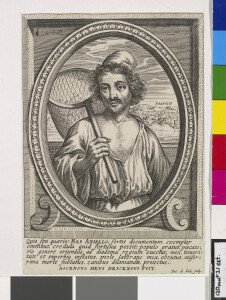
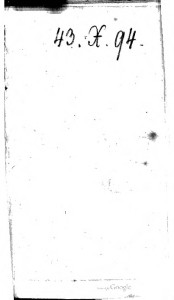
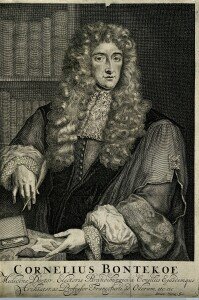
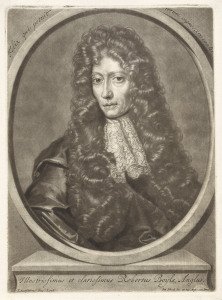
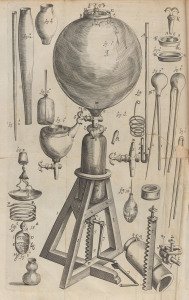
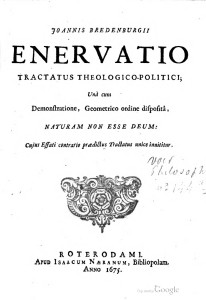
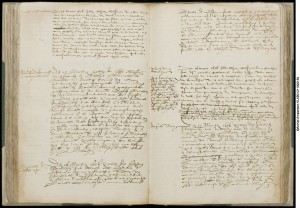
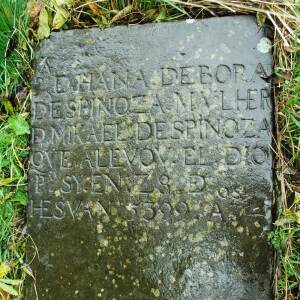
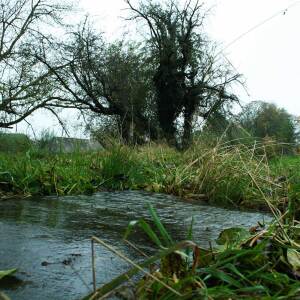
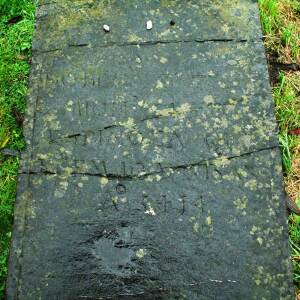
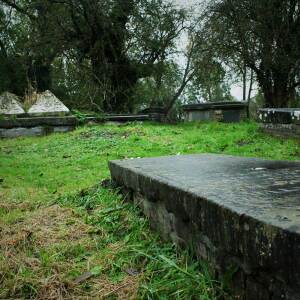
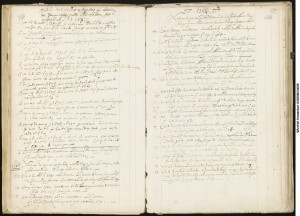
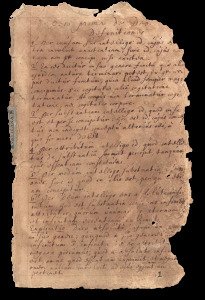
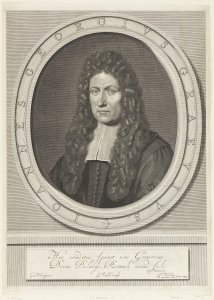
, ms. ‘Protocolboeken’, inv. no. 15 (1)-largethumb.jpg)
, ms. ‘Protocolboeken’, inv. no. 15 (2)-largethumb.jpg)
